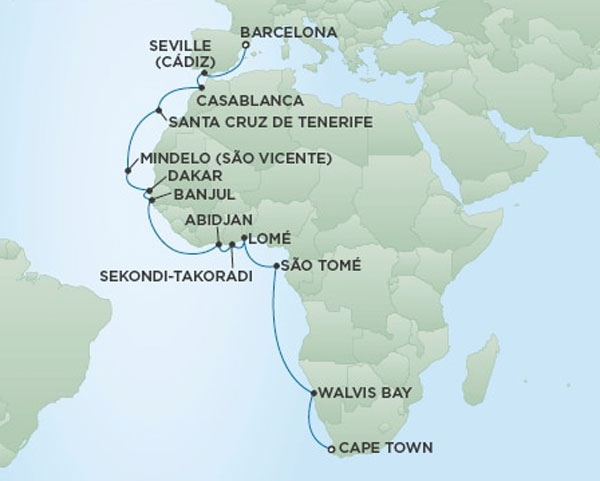
Barcelona to Cape Town
November 14 to December 14, 2023
Mike and Judy Henderson
After visiting Barcelona some years ago, and really enjoying it, we wanted to return. And we have an interest in seeing some of the coast of Africa. This cruise looked attractive to us. [Note: This map is a bit out of date due to changes in port stops since it was created.]

+++++++++++++++++++++++++++++++++++++++++
11/13/2023 (Monday) The day before departure was Judy's Birthday. We've celebrated her birthday while on trips several times, but this time we missed by one day:-)
We went to lunch with our friend Lynn, and she took this picture of us as Judy was getting ready to blow out the candle.
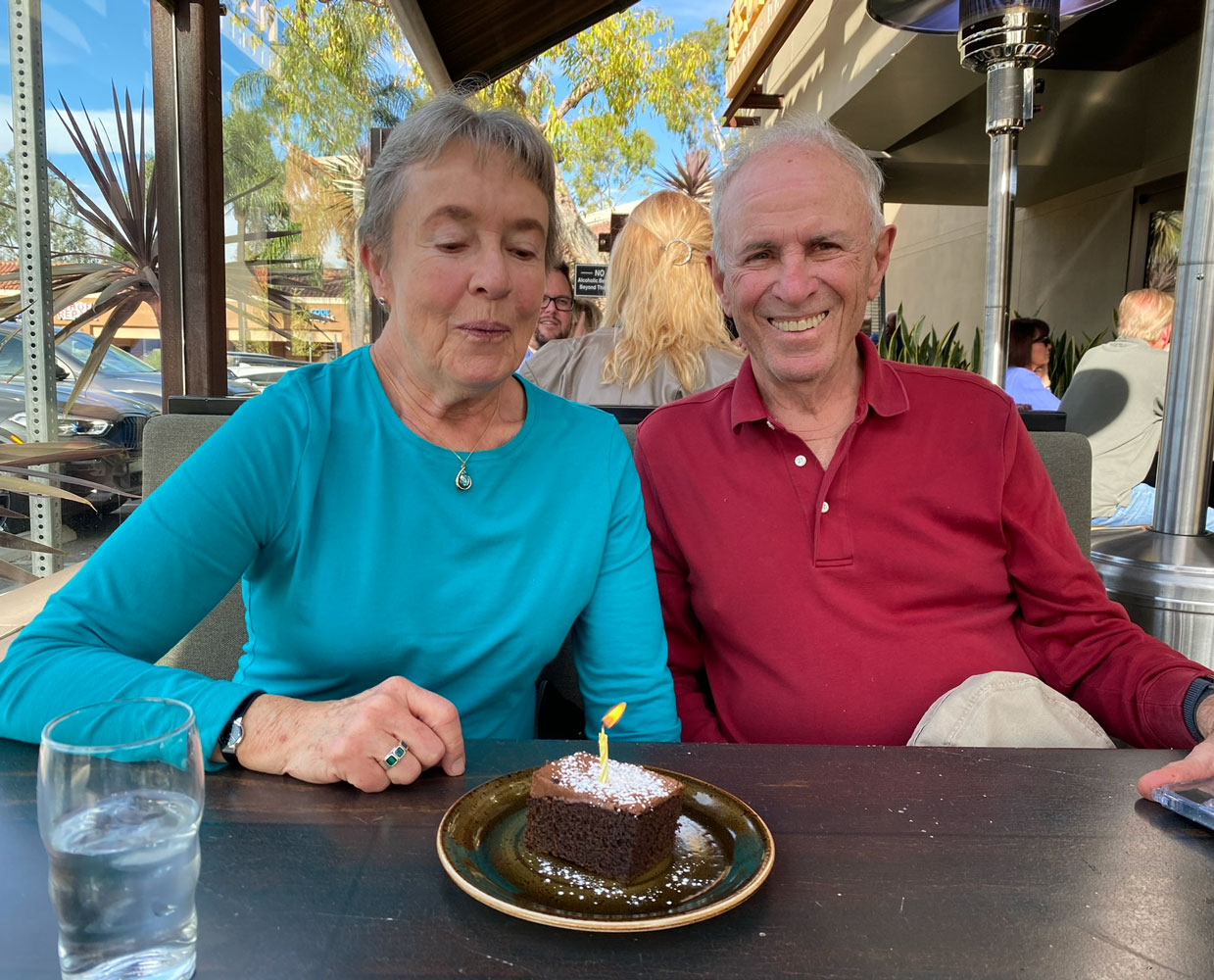
+++++++++++++++++++++++++++++++++++++++++
11/14/2023 (Tuesday) Our 1:30pm limo pick-up gave us time this morning to make final preparations for the trip. Our friend Greg is going to stay in the house while we're gone to take care of Annie and Lizzie. He can work from home, and already has his computer set up at our kitchen table. There are a lot of things we wanted him to know about running the house while we're gone. He can text us, but we'll be eight, nine, or ten hours ahead of LA at different parts of the trip.
The girls love him and will enjoy being able to stay home.
The limo arrived early, and Lynn took our traditional pre-travel photo.
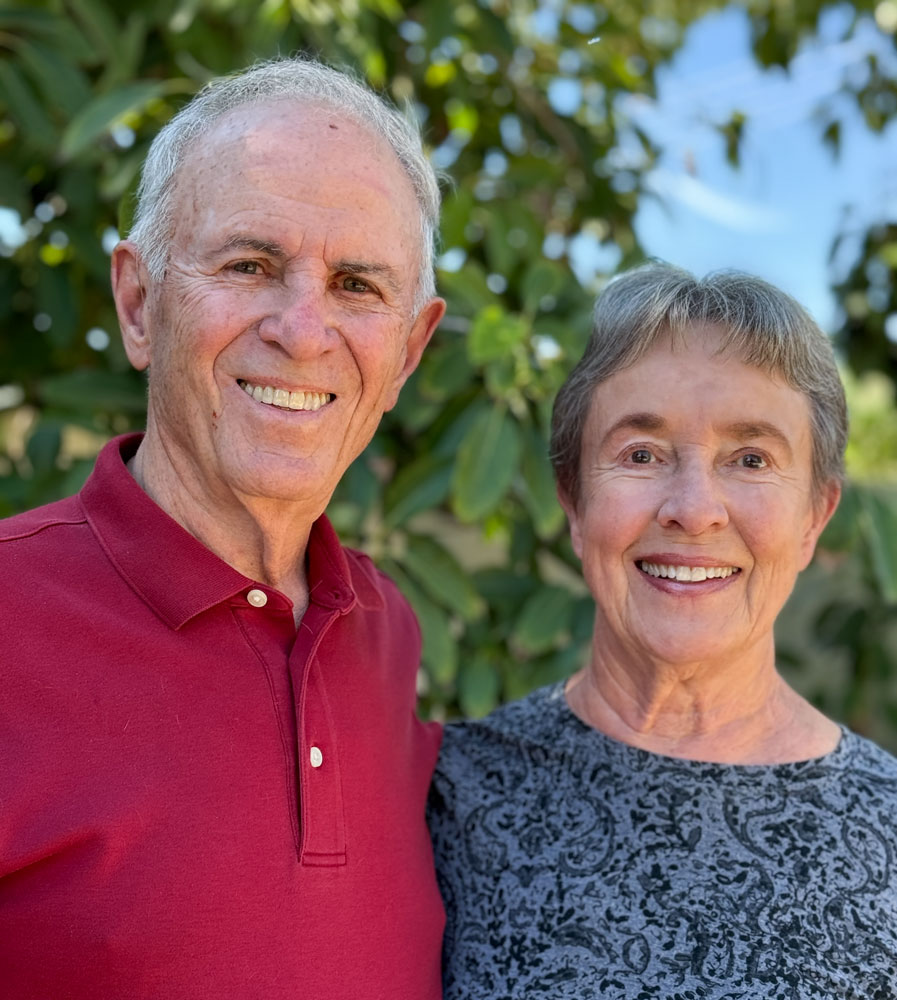
Traffic wasn't too bad, and we arrived at the airport a bit after 2pm. Our flight departs at 5:30pm so we had some waiting ahead of us. Being able to use the lounge makes it fairly comfortable. The terminal was not very busy - we checked in and cleared security quickly.
We boarded the flight on time. It's a Lufthansa A380-800 but, apparently, one of the older ones. Judy and I managed to get a bit of sleep during the flight.
One humorous thing that happened during the flight was when the flight attendant offered me "wheel" for dinner. I had no idea what she was offering me. Then she said "young beef" and the light came on. What she was saying was "veal" but the "V" in German is pronounced like an English "W" - veal becomes wheel.
+++++++++++++++++++++++++++++++++++++++++
11/15/2023 (Wednesday) We arrived in Munich on time, about 1:30pm local time. We had to clear passport control, which took some time, but our flight to Barcelona didn't leave until 3:30pm, and we were able to get to the Lufthansa lounge about 2:20pm.
We went to the gate at 3pm, but the plane had not arrived yet. It did arrive a bit after 3pm and we boarded at 3:40. We departed the gate at 4pm.
The aircraft was a A320-200, a nice plane. We were in business class but the seats were three across on both sides, with no one in the middle seat. They served us a light meal, and we arrived in Barcelona about 6pm.
We had to wait for our luggage, but since we have AirTags in our luggage, we could see that they were both at the Barcelona airport. That really helps minimize that fear we always feel when waiting for our luggage - "Did our bags arrive?"
Soon our bags did arrive and we exited the baggage claim area and found the Regent representative.
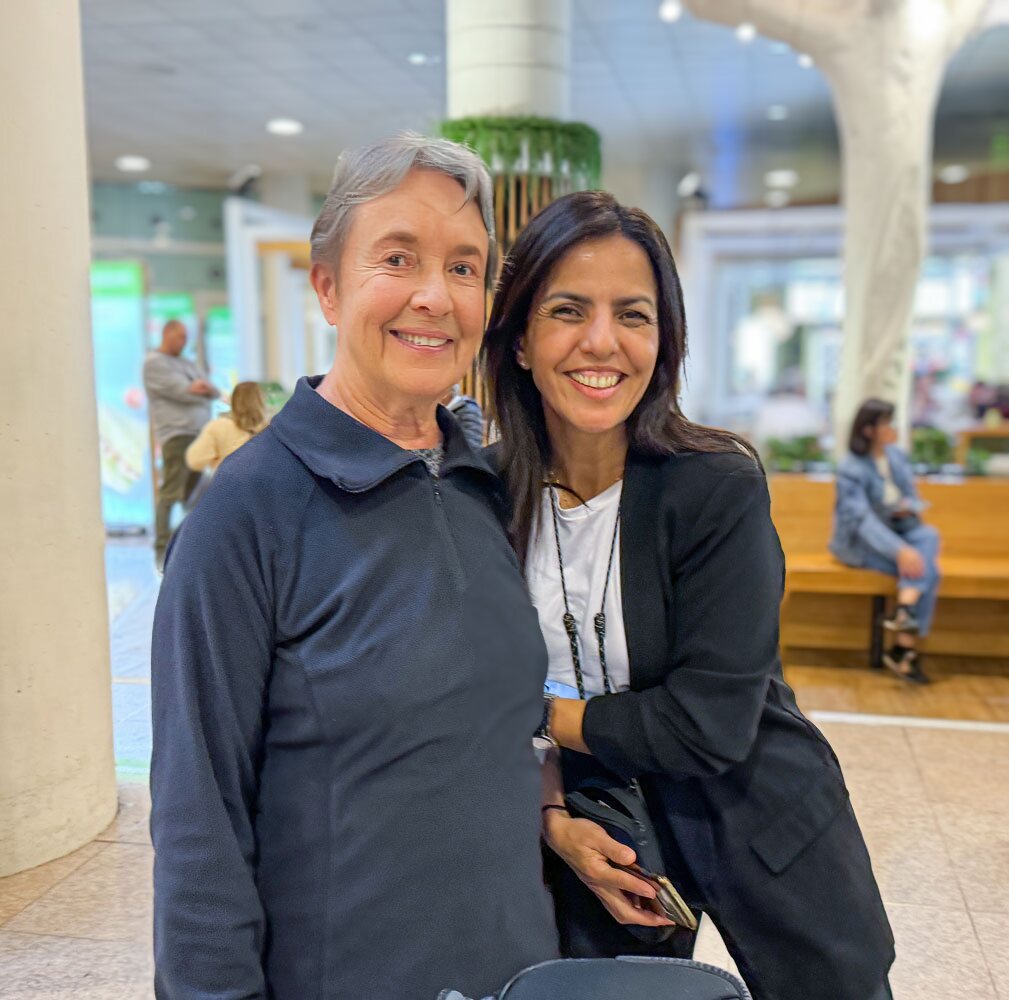
She drove us to downtown Barcelona, which is not that far from the airport - about 20 minutes. The hotel we're staying in - just for one night - is the NH Gran Calderon. It's a quirky hotel, very Barcelona. I wouldn't call it a luxury hotel but it's comfortable and clean.
+++++++++++++++++++++++++++++++++++++++++
11/16/2023 (Thursday) As usual, Judy and I woke up at 3am this morning, so we got up and took our time getting ready. We met the Regent Tour Director at 9am in the lobby for a bus to Montserrat to visit the Santa Maria de Montserrat Abbey. I haven't done any research on Montserrat so I'm an open book. Montserrat translates to "serrated mountain". Mont=mountain, and serrat=serrated, as a knife might have a serrated edge.
Here's a picture of the mountain. You can see that the multiple peaks give it a serrated edge look. The geology of the mountain is interesting - you can read about it here and here. But I'm getting ahead of myself.
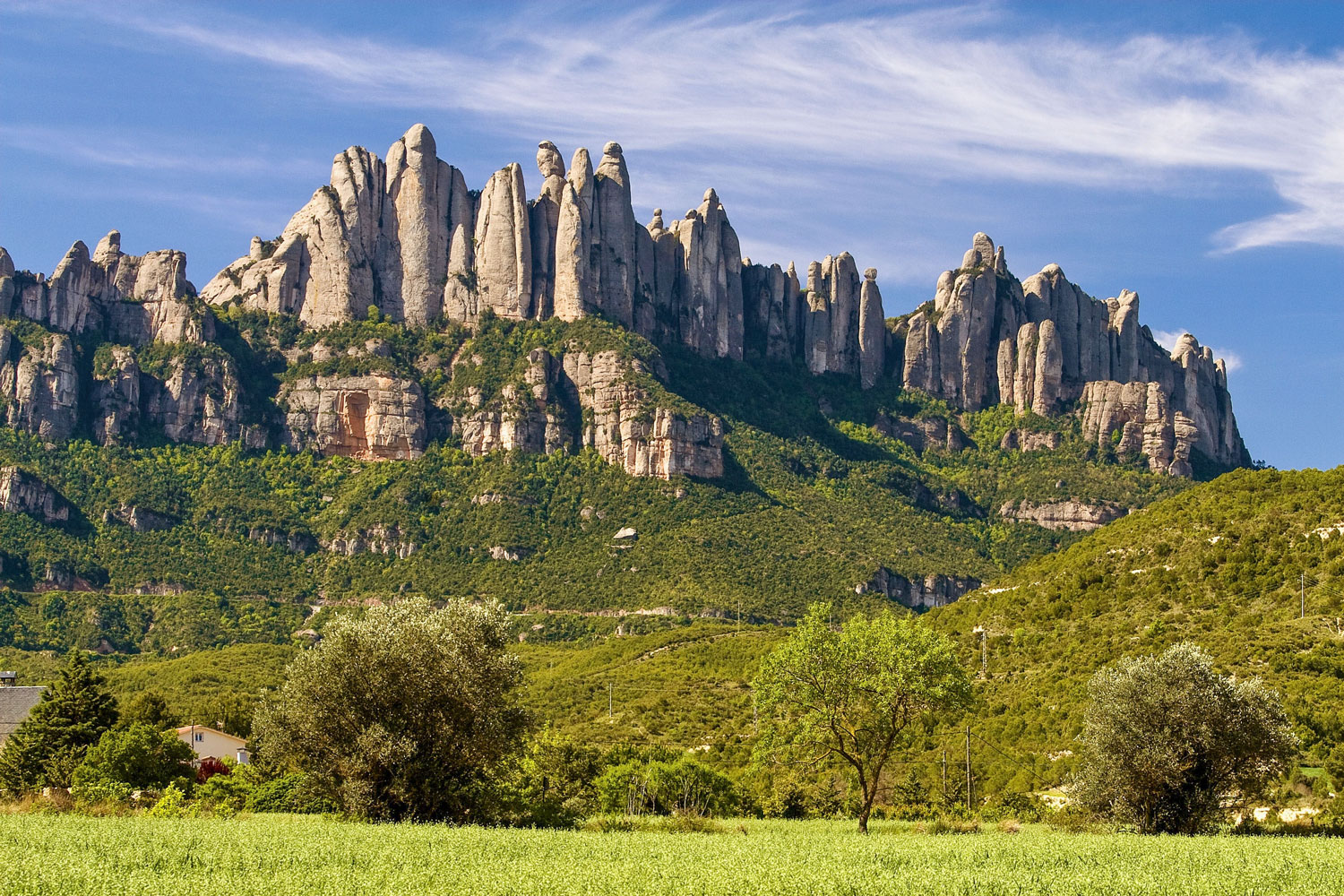
We met our guide, Maria Barrera, in the hotel lobby at 9am.
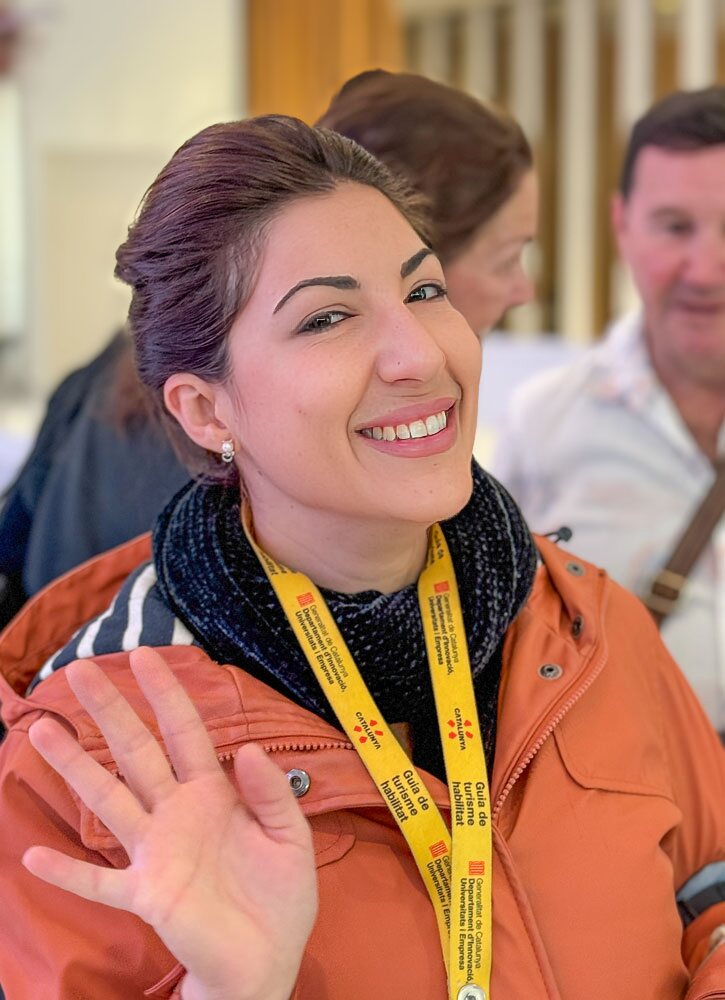
Our small group of nine had lots of room in this full-sized bus.

Our luggage was put on the bus - we'll be at a castle in Cardona this evening. We departed Barcelona, heading to Montserrat and the Santa Maria de Montserrat Abbey, built high in the mountains. Here's an aerial view, taken from the web. The entrance road is towards the top of the picture. Those are buses parked there.
The monastery was founded in the 11th century and is still operational, with 70 monks.
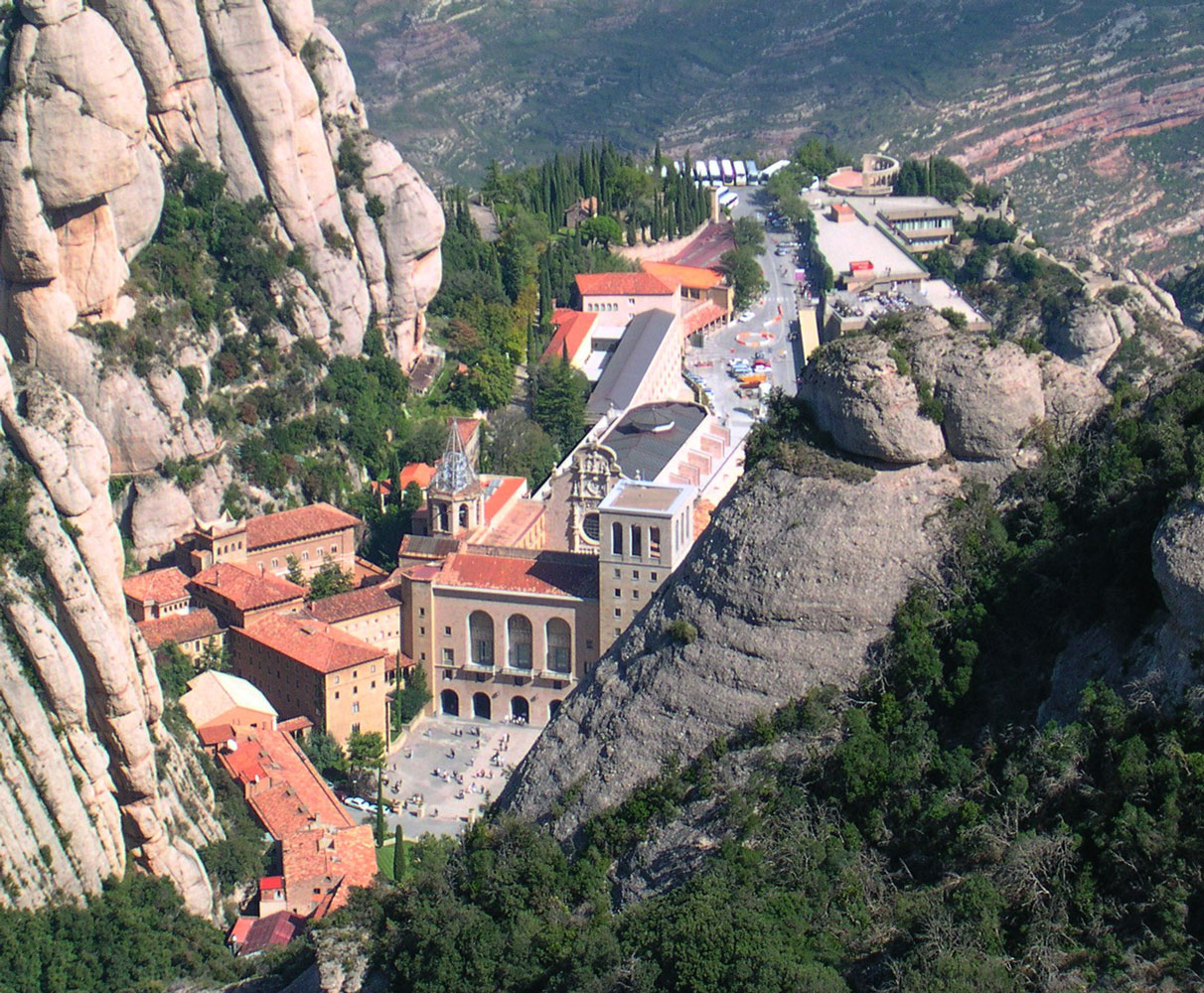
Our guide told us that, for the Catholic Church, tourist revenue from the monastery is second only to the Vatican.
The bus took us to Montserrat Ville in Monasterio de Montserrat where we caught an electric cog wheel train to the monastery area. The train is interesting because there are two physical trains and they run synchronously in opposite directions between the monastery and Montserrat Ville on one track. About half-way up, the train track splits into two tracks and the trains can safely pass each other. It's like a funicular but without the cables - two trains, one going up and one going down, carefully choreographed so that they meet in this one location where the track splits into two tracks.
There was a nice view of the valley as we rode the train up the mountain, but there were really bad reflections in the train windows which prevented me from getting any decent pictures.
Here's a picture of the train after we arrived in the area of the monastery.
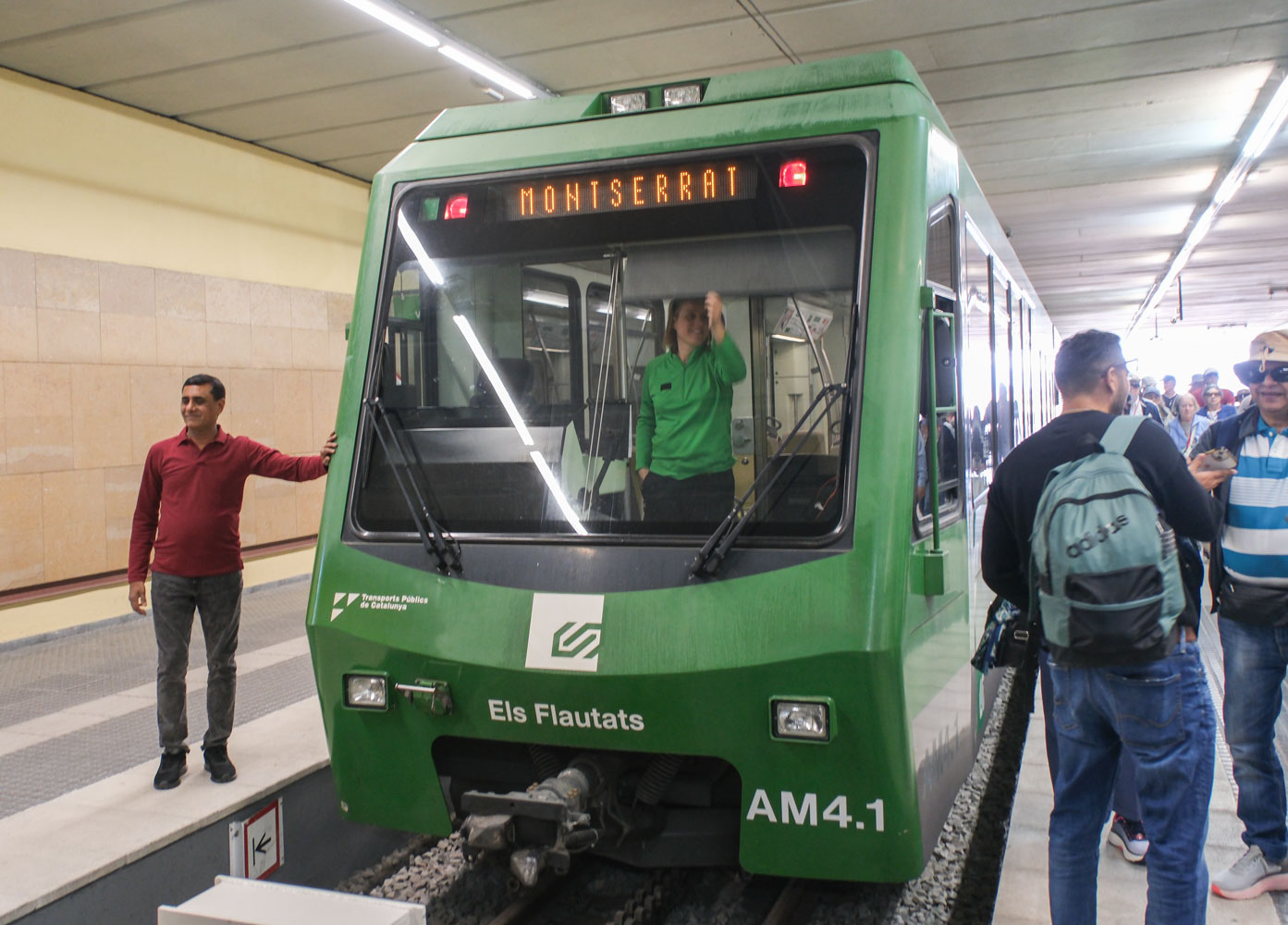
Here's another picture of the train, taken from the web, as it arrives at the monastery station.

There is a road to the monastery, and when we left, we walked to the parking area to board the bus.
You can also get to the monastery via a cable car.

All of the "transport" methods arrive in the same area as the train station. One transport I thought was interesting was a very steep funicular to Sant Joan (yes, it's Sant, not Saint). We didn't go up there, but it might have been an interesting ride on that funicular.

We walked around the area of the monastery as Maria told us of some of its history. It was originally built in the 11th Century but was rebuilt in the 1800's and 1900's after it was destroyed during the Peninsular War, which involved Spain and the UK allied against France. We walked toward the courtyard of the monastery, which you can see in the aerial view of the monastery I posted earlier. In the lower center of this picture is an art museum.
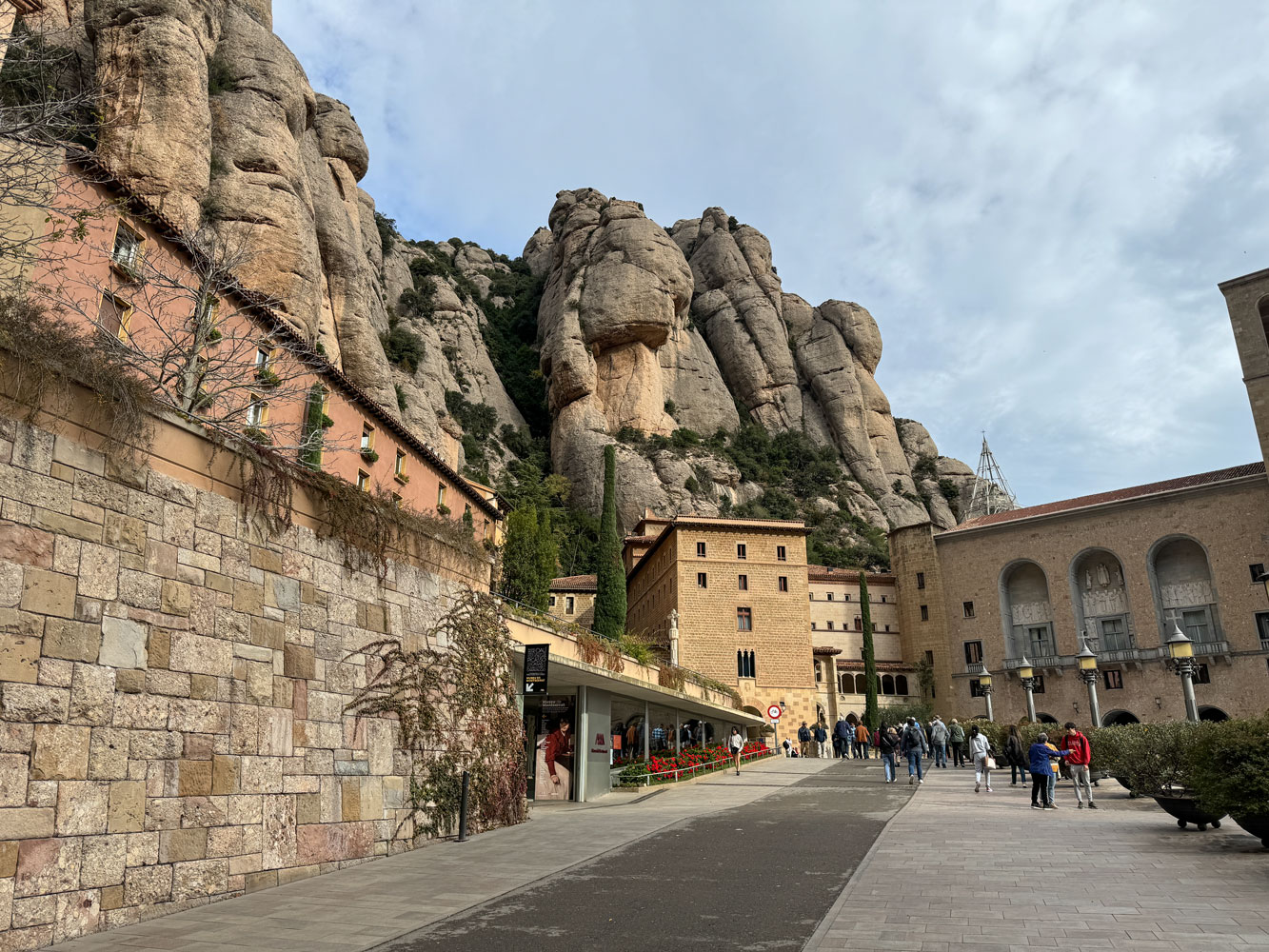
The major attraction of the monastery is the statue of the Black Virgin of Montserrat. Maria had to get tickets for us to go up to the statue. Our reserved time for that event was 12:30pm, which gave us time to wander around the monastery. Judy and I went to the art museum.
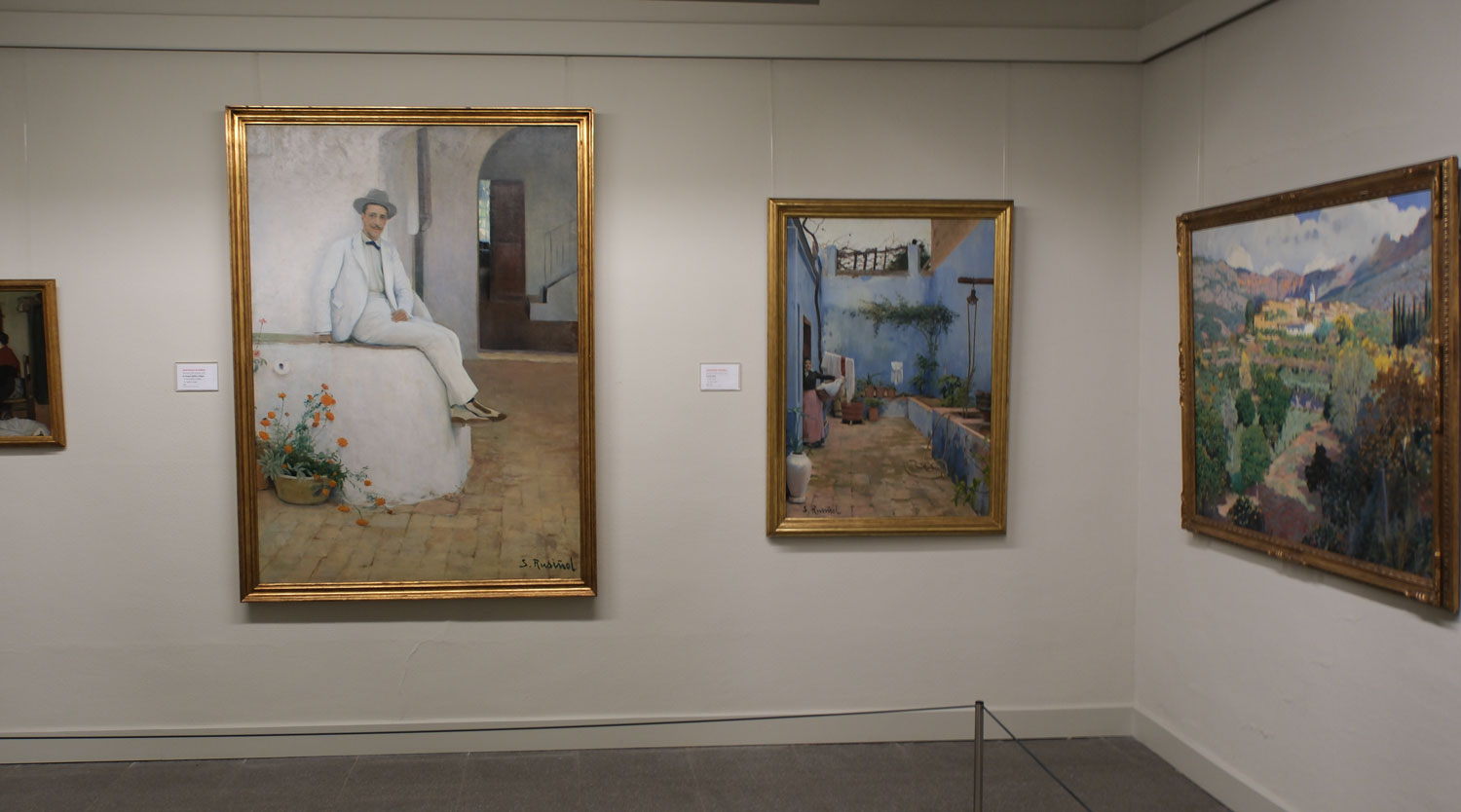
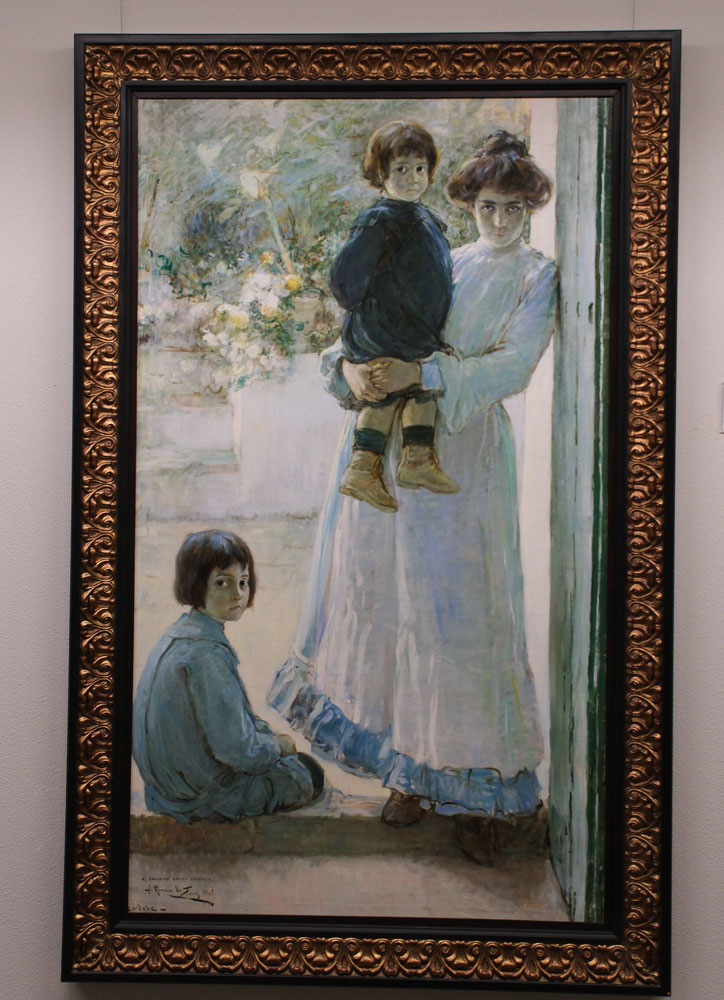

Then it was time for us to go back to the church to see the Black Virgin. We had to wait a while to gain entrance but we finally got in and walked along a corridor, then entered from the right, up stairs, to the location of the Virgin. It's not obvious in this picture, but the statue is behind a curved glass shield, with a hole cut in the glass so that the orb she is holding is partially out of the glass. This is so that a visitor can touch the orb. Legend has it that if you make a wish while touching the orb, it will come true.
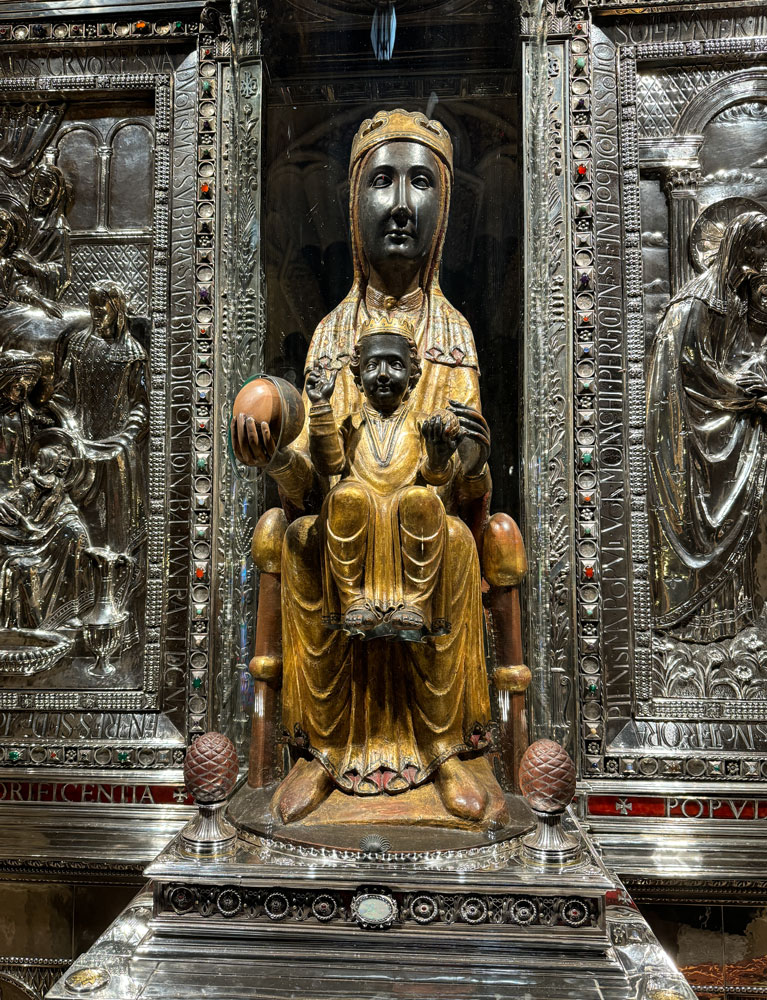
Here's Judy touching the orb. I wonder what her wish was, and whether it will come true.
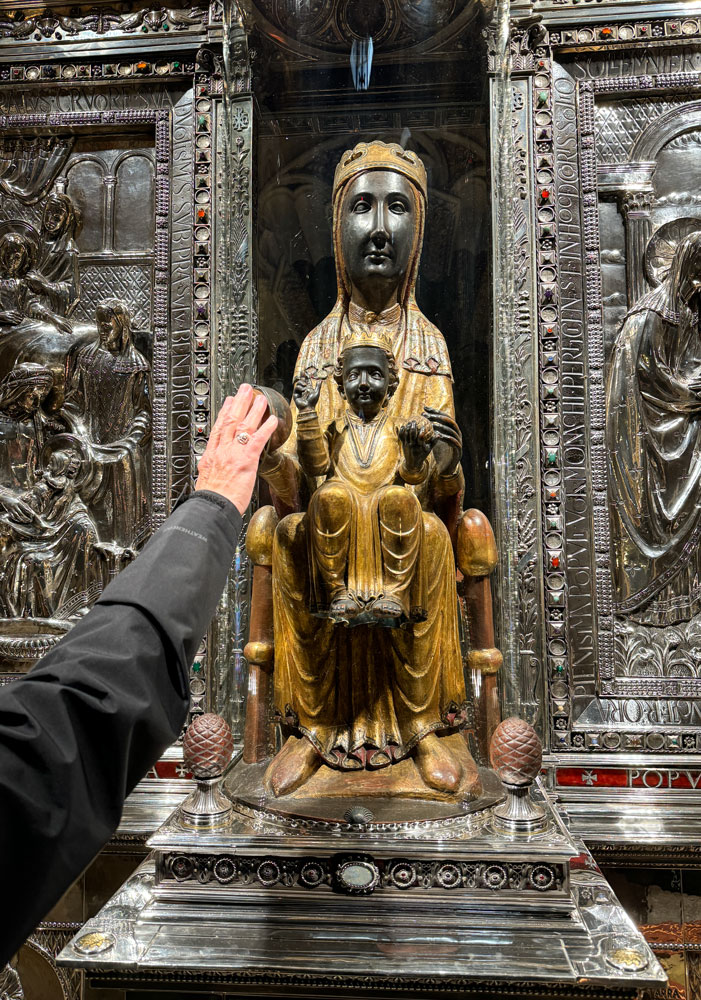
The statue was carved in wood in the 12th Century. Note that the faces and hands of the individuals depicted are black. It's possible that the statue darkened from candle smoke in the early part of its existence, but the faces and hands are black from having been painted with black paint during restorations.
The statue is located above the altar area of the Basilica. In this next picture, taken from the web, the statue is in the arched structure in the center of the picture. The statue is hard to see because a visitor is standing in front of it.
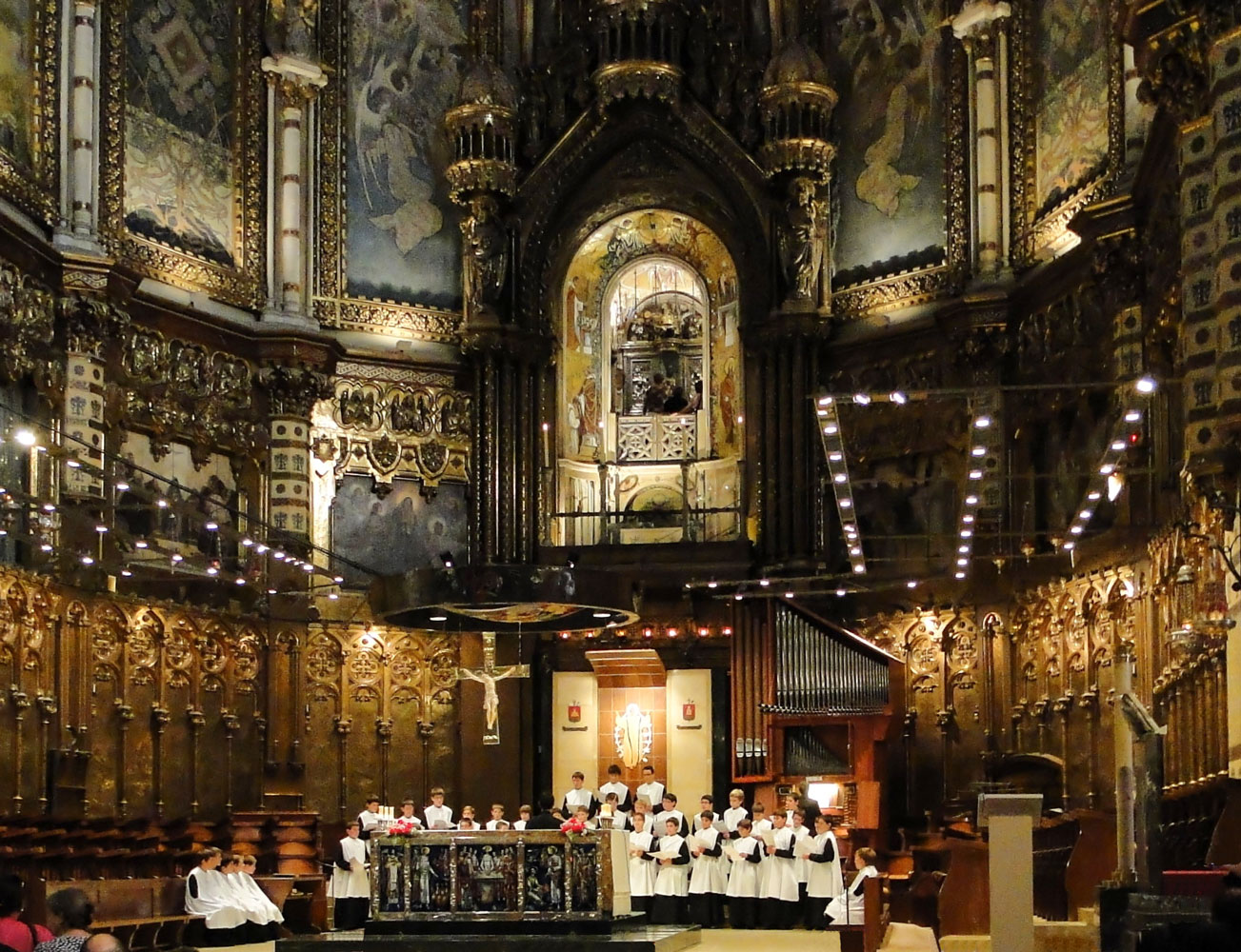
As we left the Black Virgin, we walked through an alley where there were candles along the right side. You can purchase a large or small candle to place in one of the racks. The large candles were €3.50 and the small were €2.50.
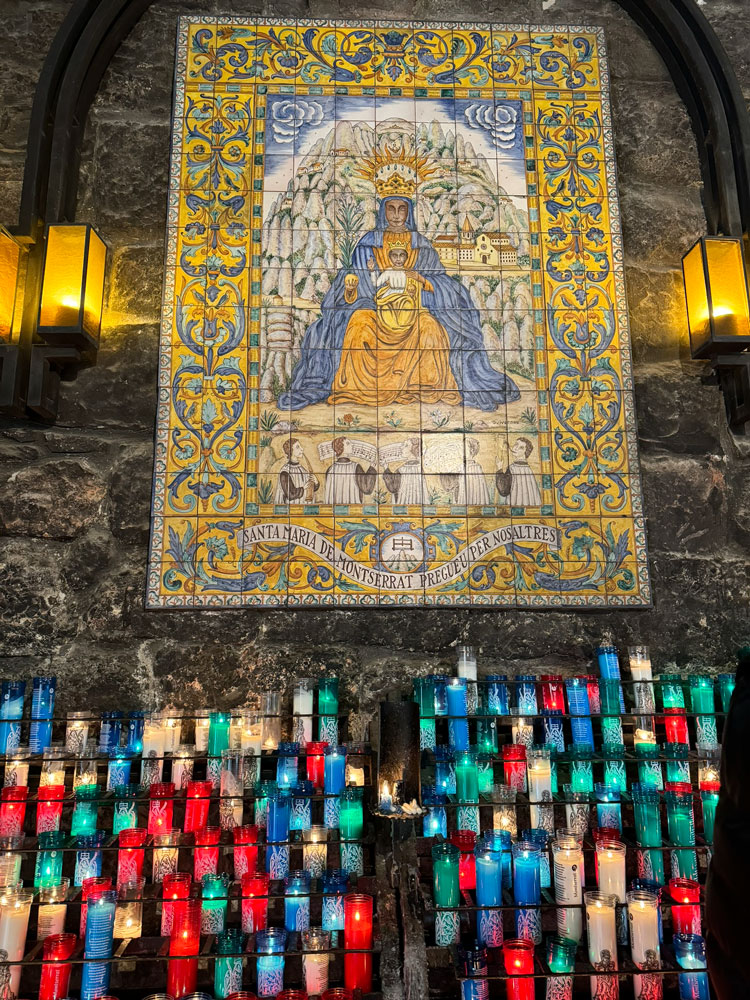
It was now time for lunch and we went to the Hostal Abat Cisneros restaurant just off the square, and had a very nice lunch.
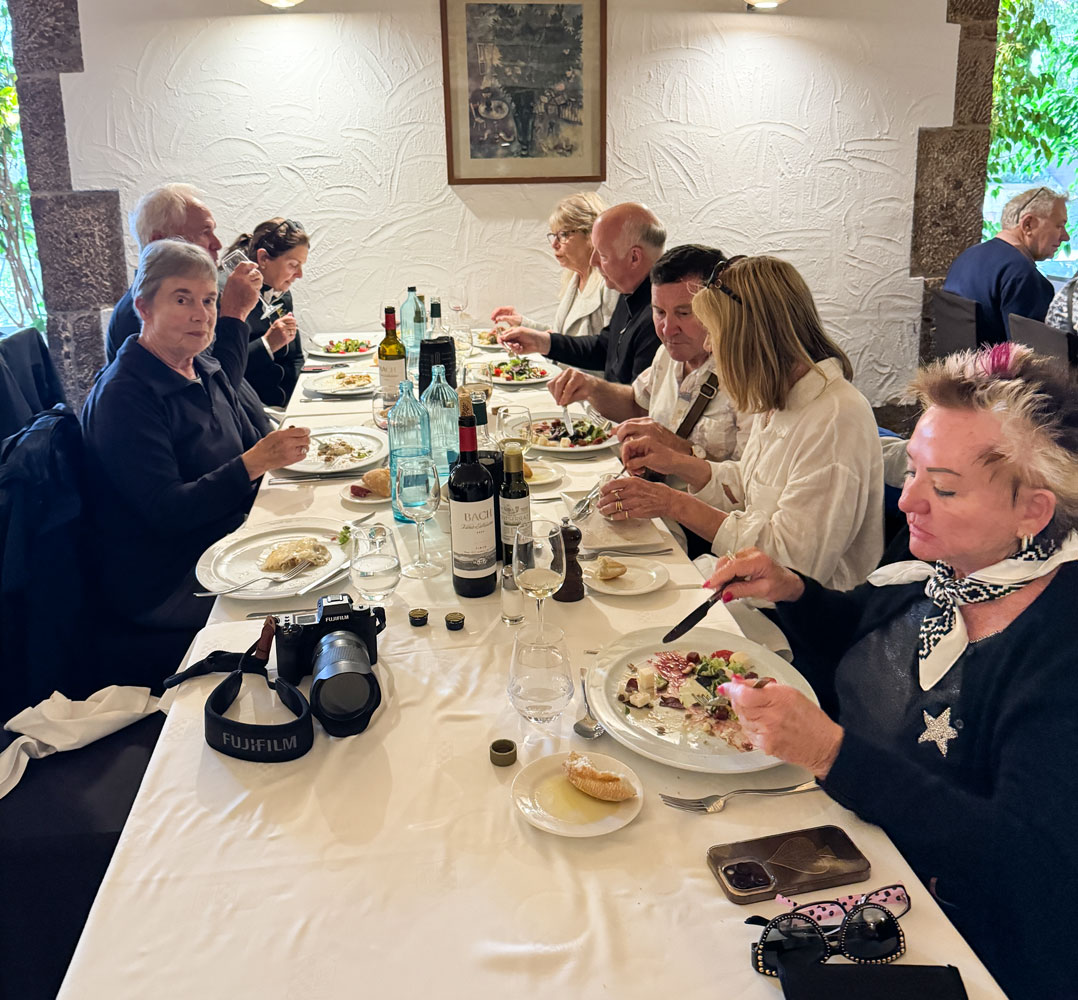
After lunch we went to the bus, which had driven up the road to the monastery and was parked in the parking area. The bus then took us to Parador de Cardona, a hotel in the Castle of Cardona, located in the town of Cardona. Picture from the web. In Spain, a Parador is a state owned luxury level hotel in a converted historic building such as a monastery or castle.
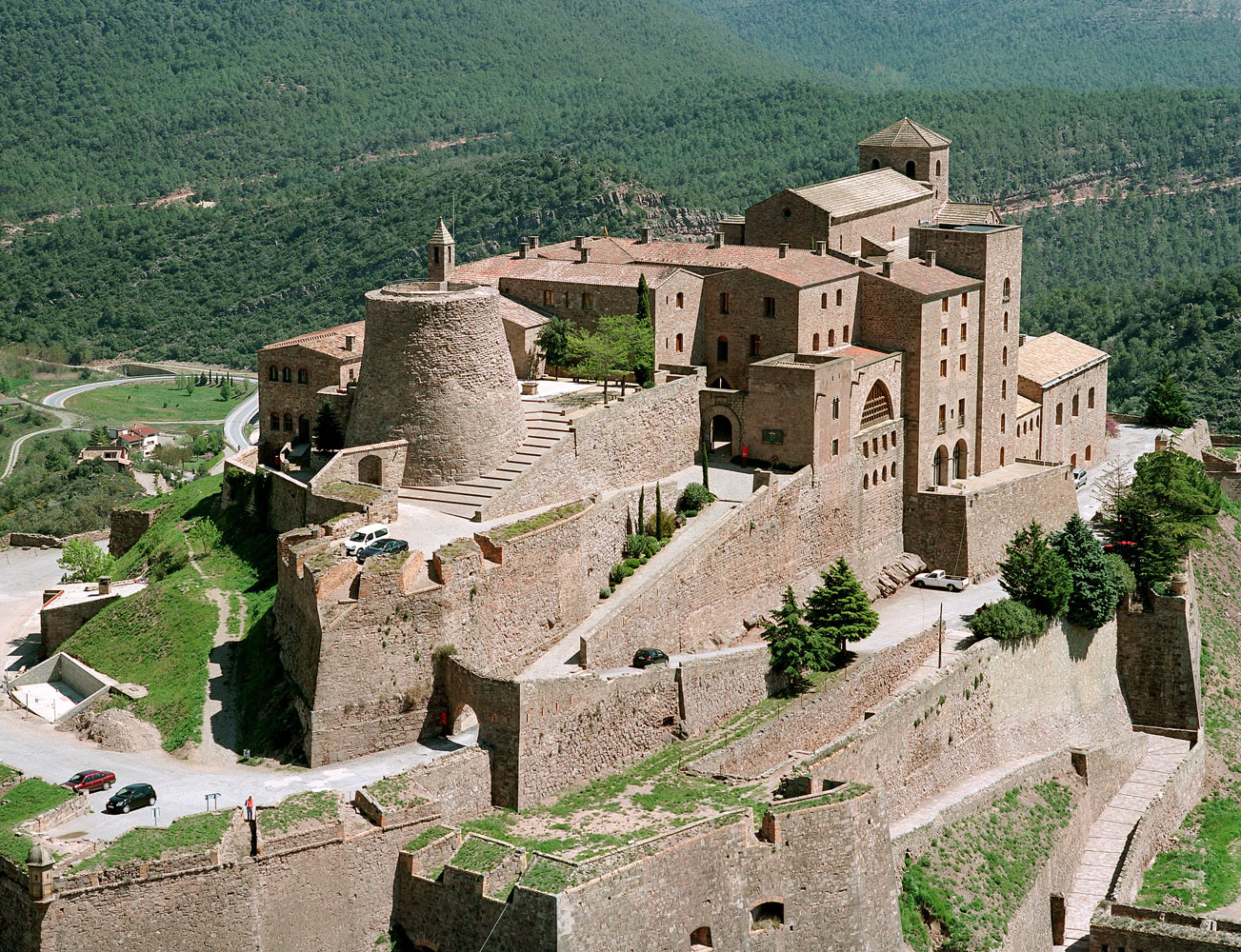
We have a room on the 7th floor, with a good view of the town.
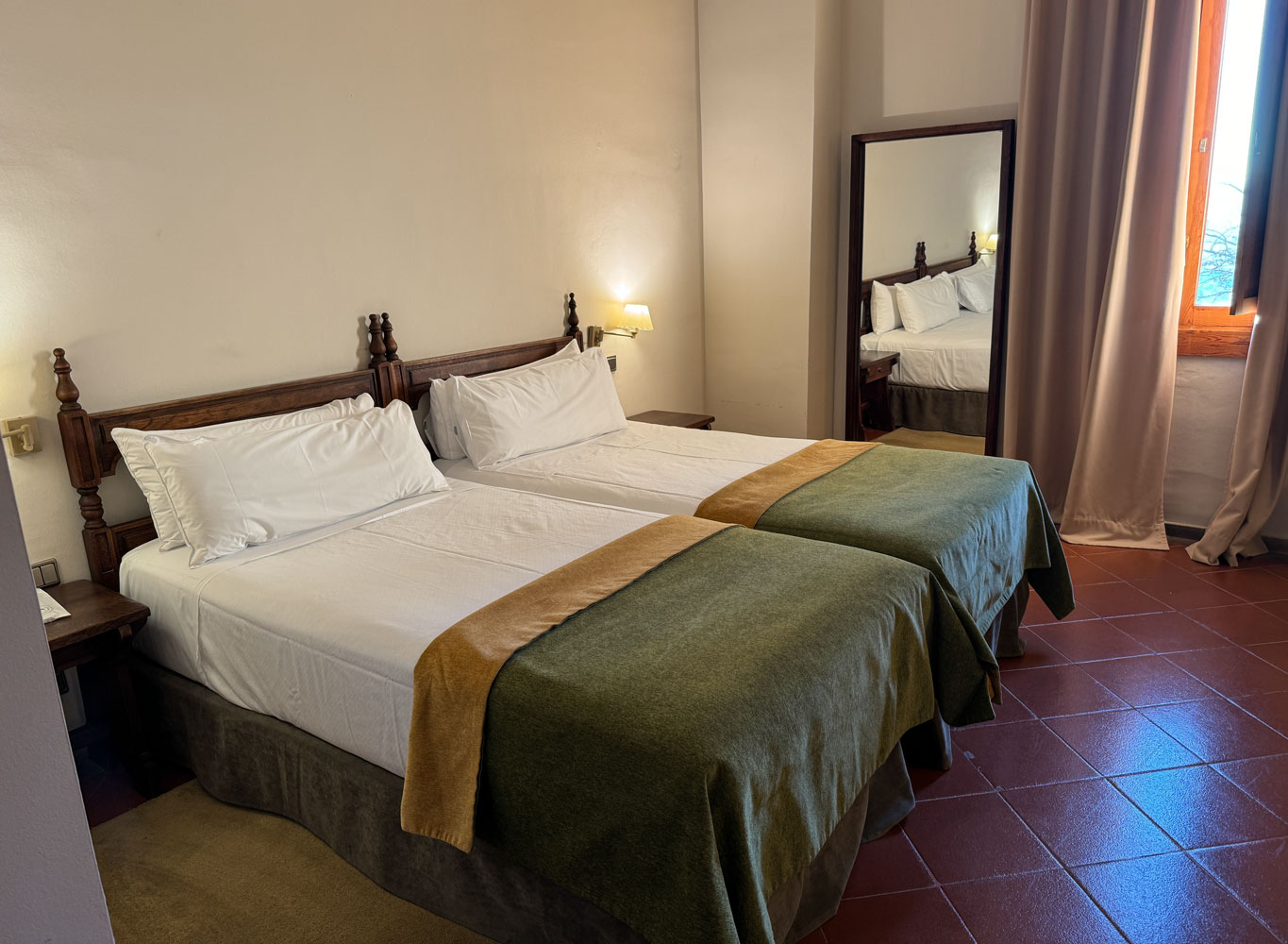
We had some time before dinner, so Judy and I walked down to the town. The castle is built on a hilltop, so it's quite a distance down to the town, more than is apparent in this picture. The area to Judy's left is built for "horse steps".
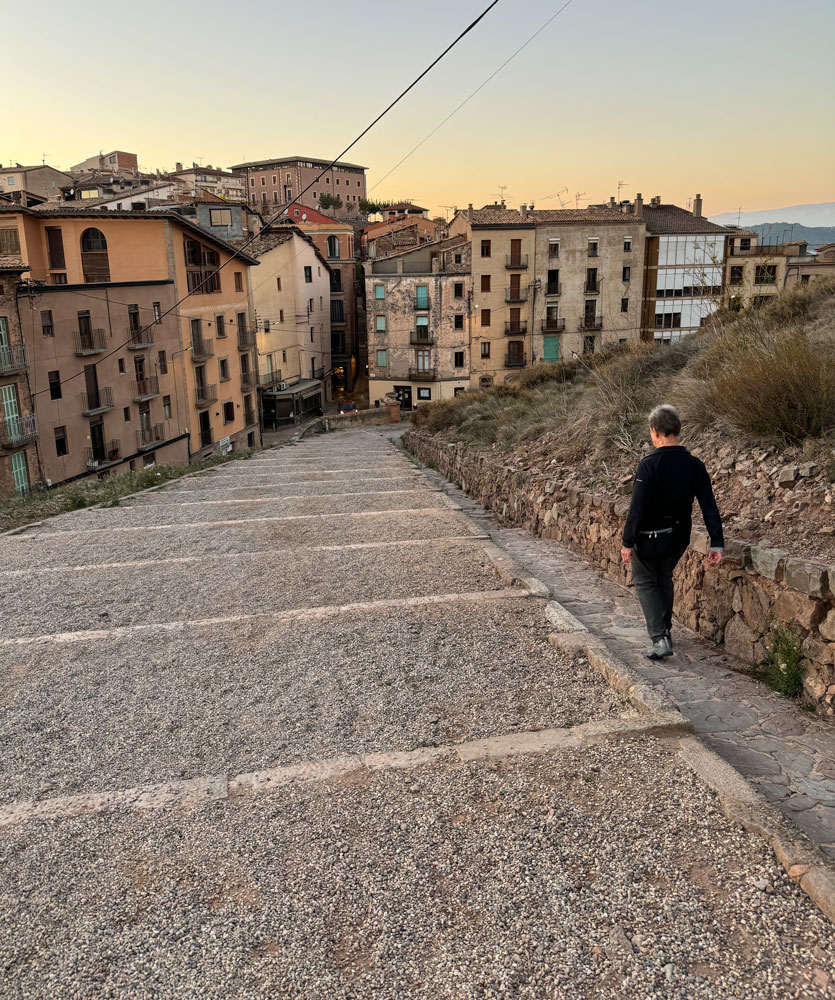
The town was pretty quiet. It was getting late and the town is small, population about 4,600 people.
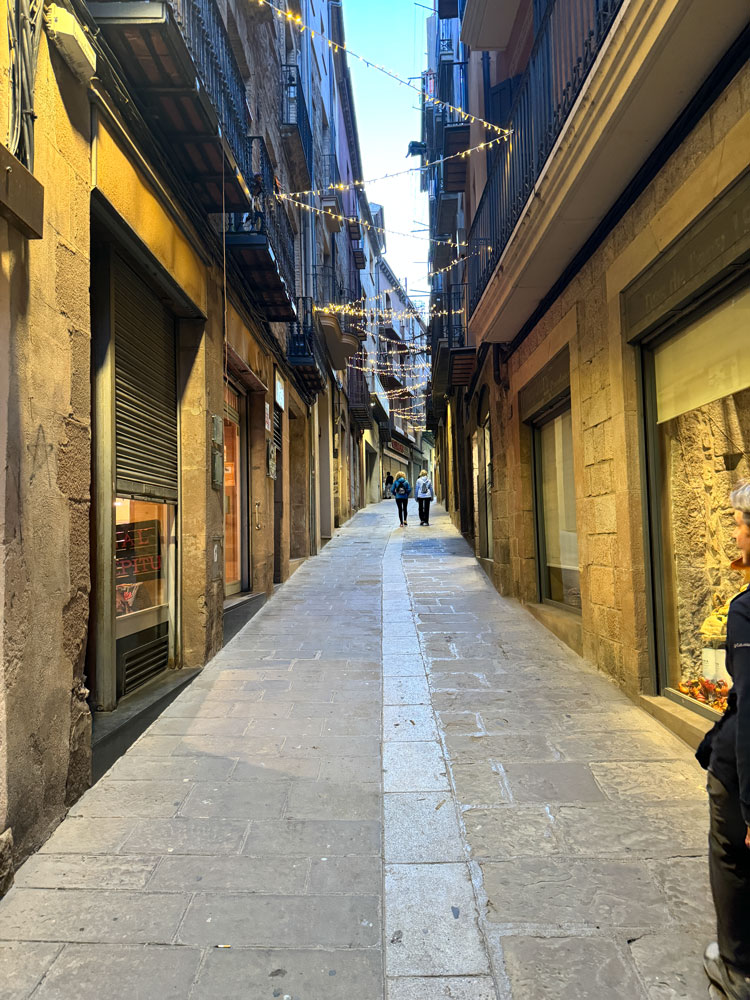
We walked to the town square but didn't have time to do much. It was getting late and we didn't want to have to walk up the hill in the dark. Even then, it was getting fairly dark as we walked back. Walking up the hill was definitely more challenging then walking down to the town, but Judy kept encouraging and helping me. (Note by Judy, not true.)
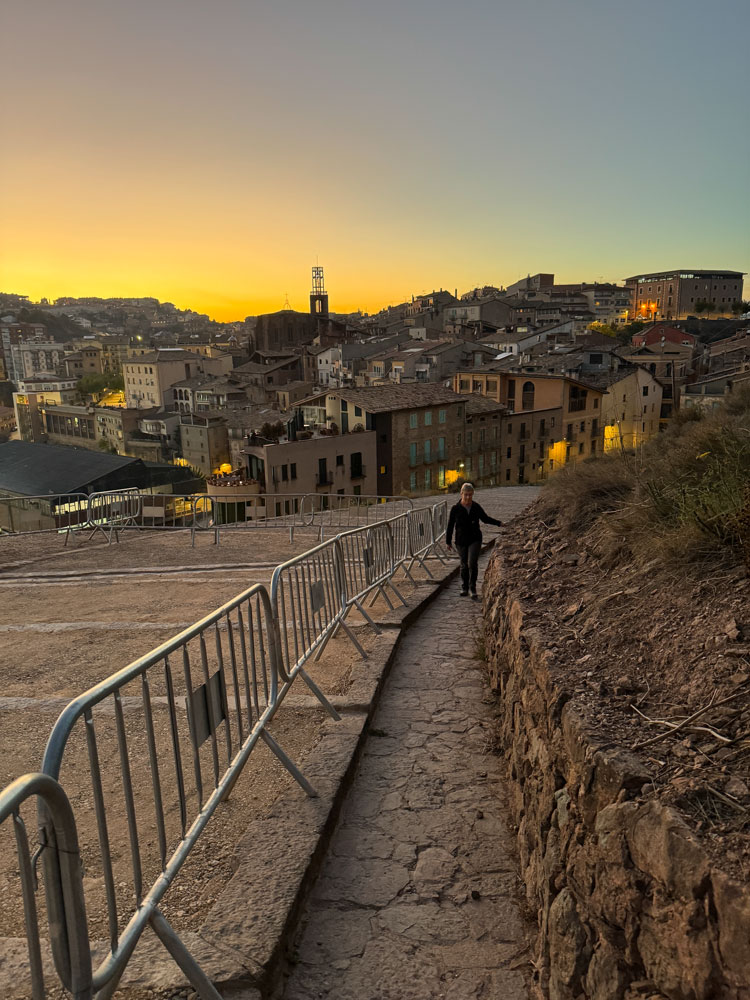
We had a group dinner this evening in the hotel restaurant. The room had previously been used as the horse stable, but has been renovated to a beautiful setting.
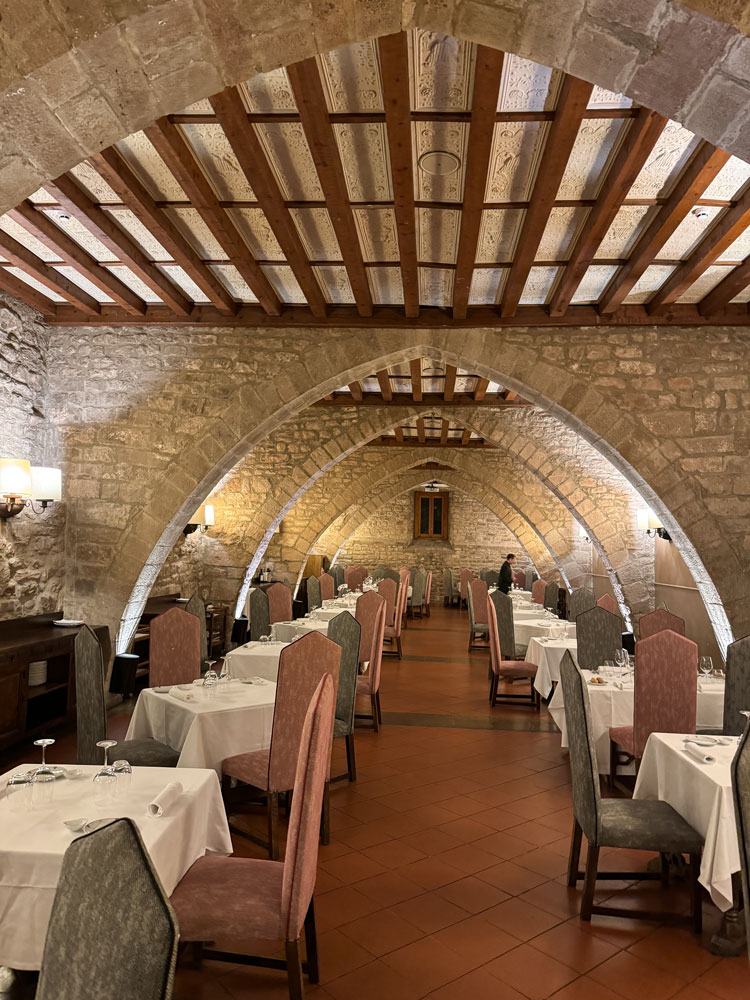
After dinner, it was to bed. We were very tired since we didn't sleep much the previous night.
+++++++++++++++++++++++++++++++++++++++++
11/17/2023 (Friday) Today we take a tour of castle, then tour the town of Cardona and finally, visit the salt mine located near the town.
We had breakfast in the hotel restaurant this morning and then met Maria in the hotel lobby at 9:15, to begin our tour of the castle. We were joined by a small group of people who are sailing on an Oceania ship out of Barcelona. Note: Both Regent and Oceania are part of Norwegian Cruise Lines.
We began at the base of the tower. Maria reported that the tower was originally twice as high but was reduced in height in the late 1900s. We climbed the stairs you see in the picture to reach the top.

From there we had a good view of the area around the castle.
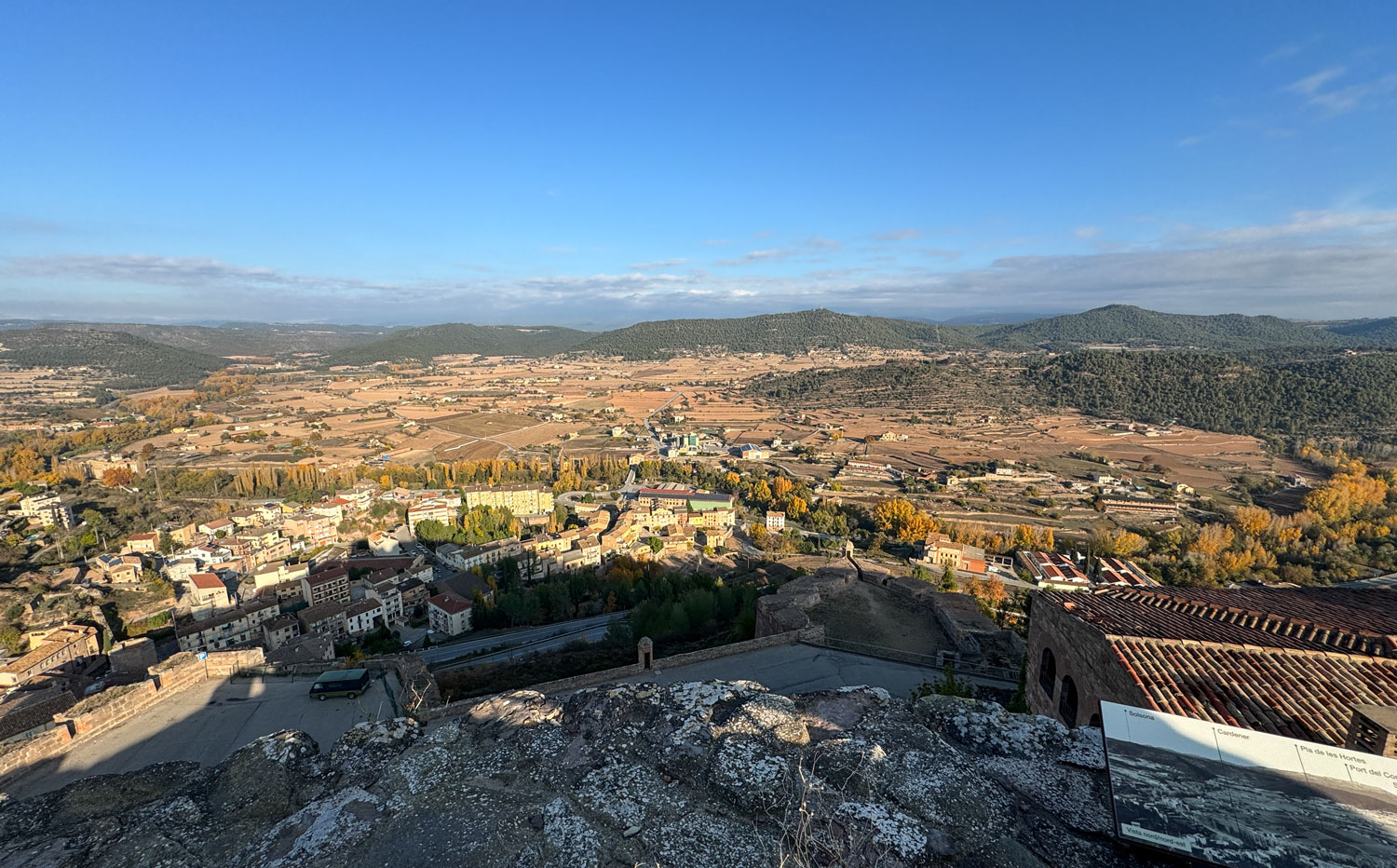
A closer view of the town of Cardona.
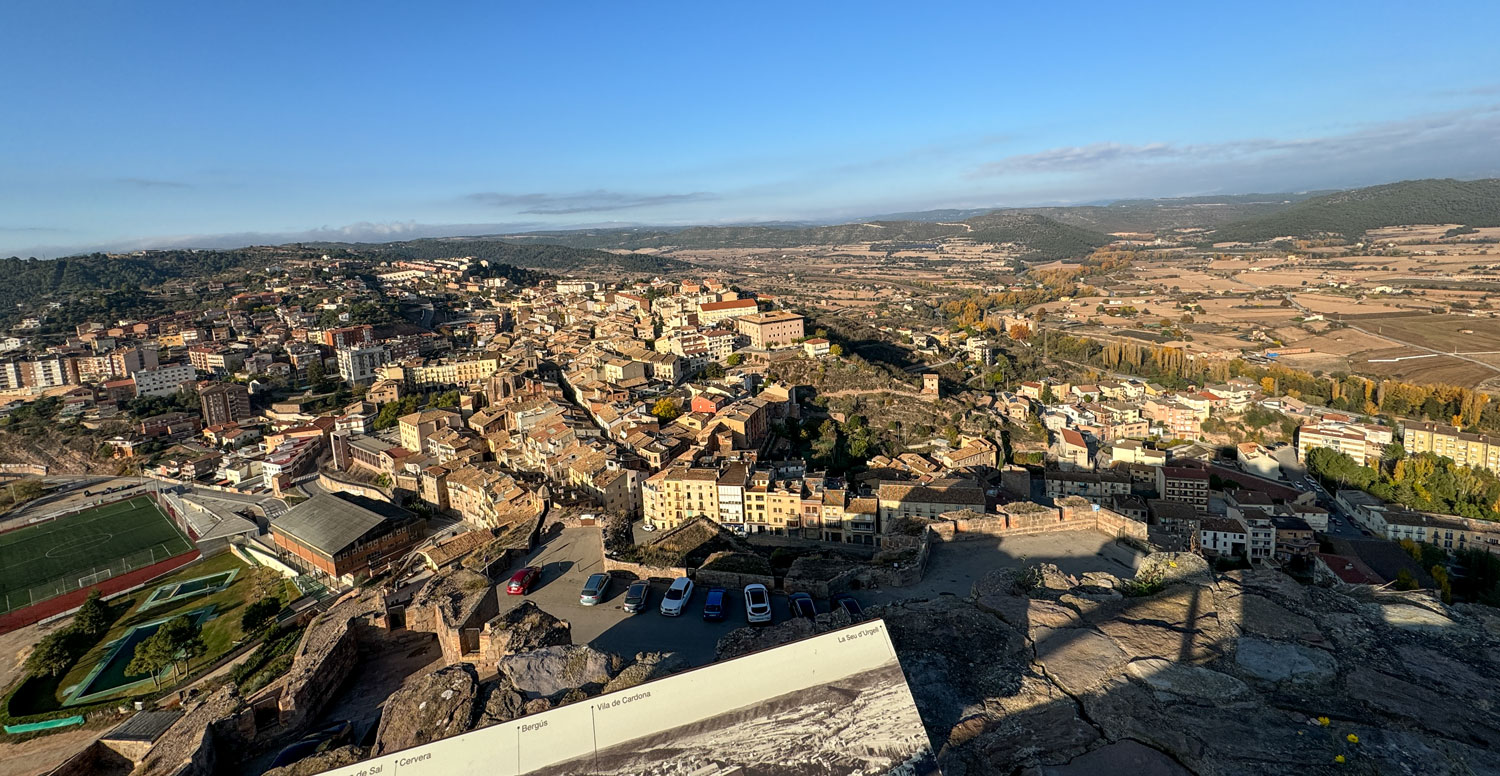
My favorite model and muse, against the town.
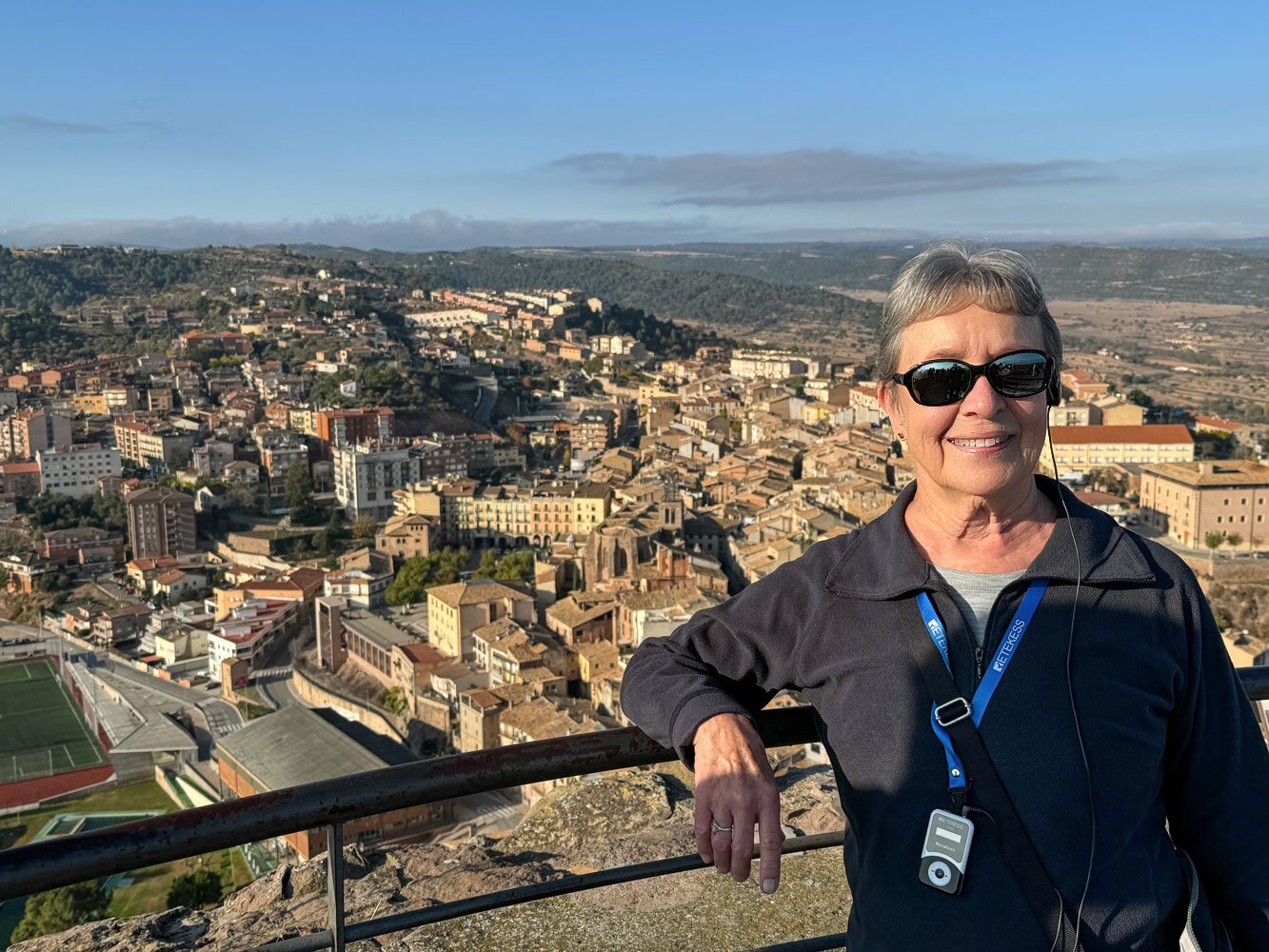
Finally, a view toward the salt mine. Here you see the tailings from the mine, which are full of salt, and create very salty runoff during rainy weather. That flowed into the Llobregat river, and the Llobregat is where Barcelona got its drinking water. Eventually, they had to change the path of the river to avoid the pollution, and to capture and treat the runoff from the tailings. That's a problem with tailings from most mines - water pollution.
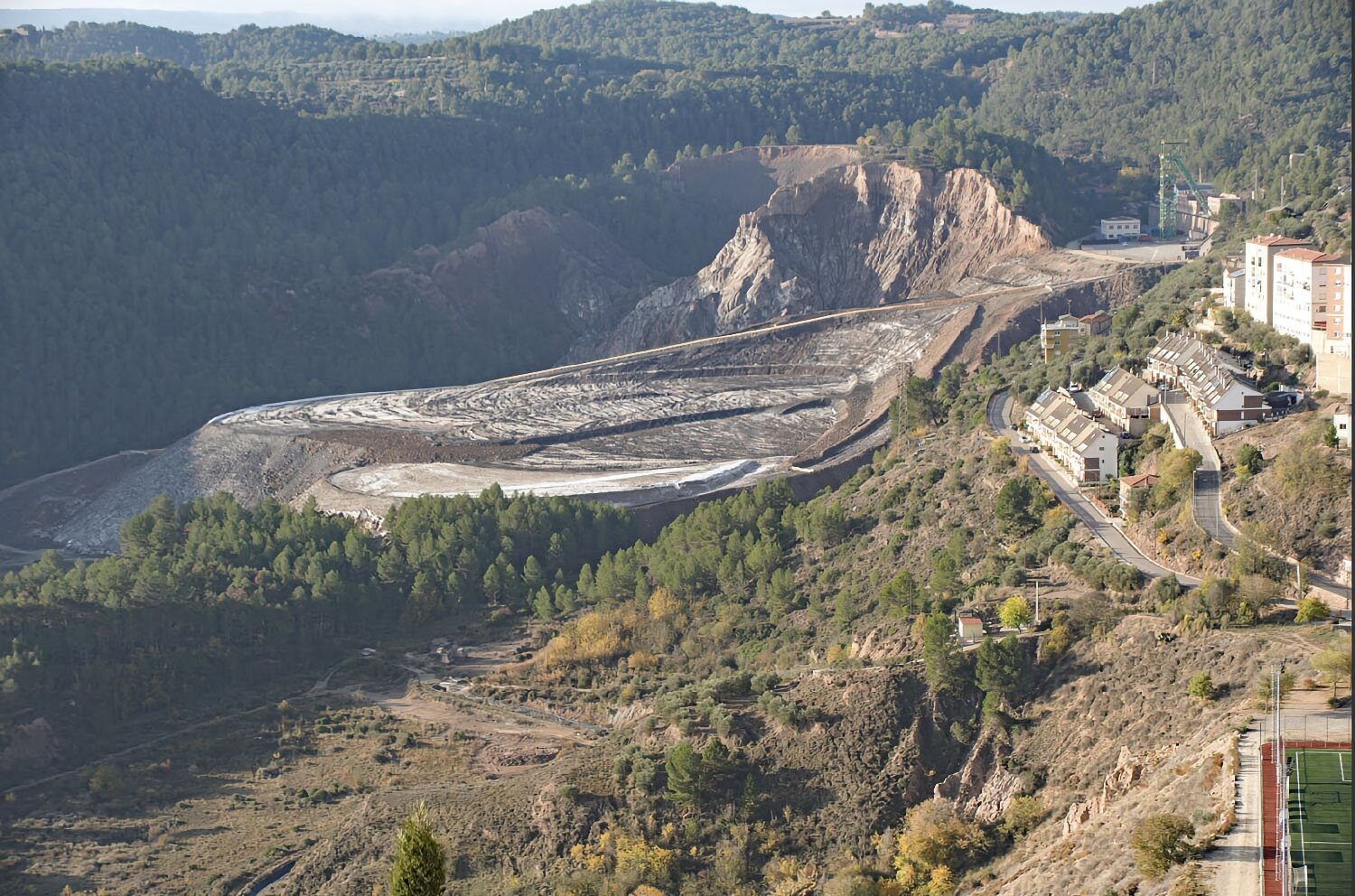
Maria was the last person to come down from the tower and she took a picture of us from the top of the tower.
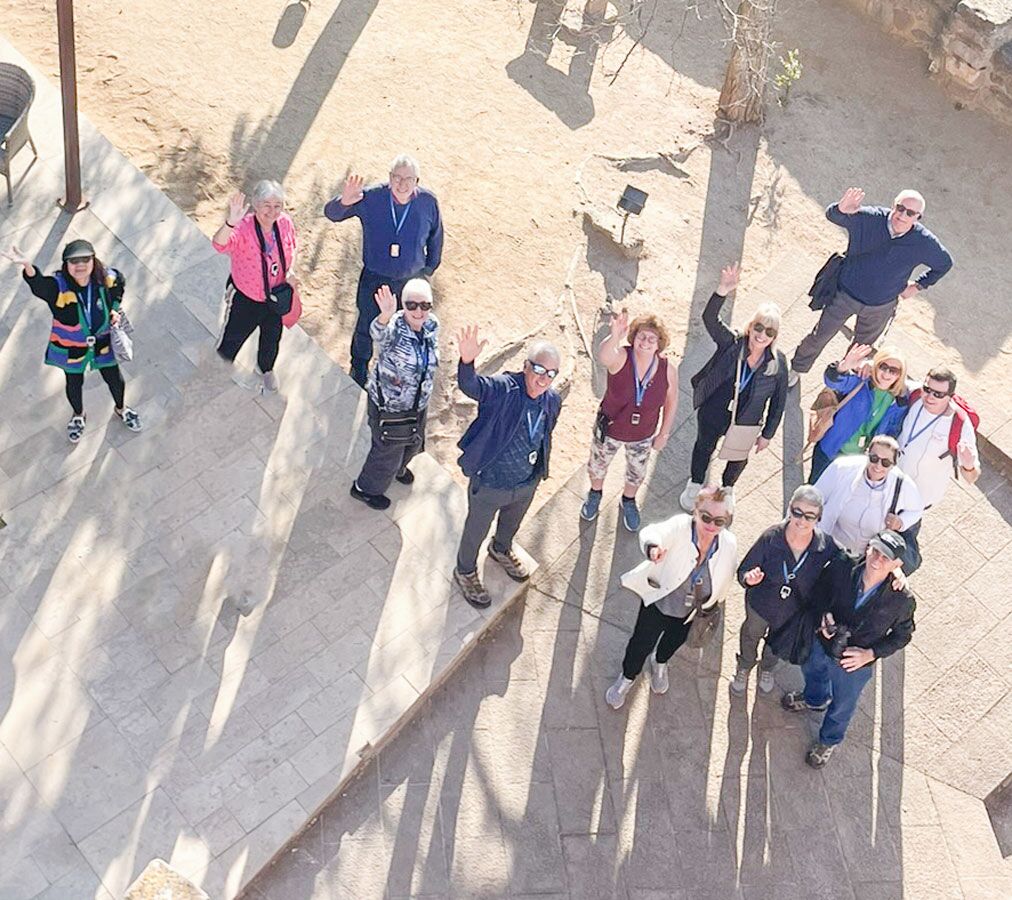
We left the tower and moved to the east side of the castle, where the Church of Sant Vicenç was located. The church is quite old, having been consecrated in 1040. It's interesting to compare the design of this church with Notre-Dame in Paris. Notre-Dame was built a bit more than 100 years after Church of Sant Vicenç but there's a significant difference between the two. This church is massive, with very thick walls and interior supporting columns. The windows are very small. Notre-Dame has much thinner walls and very large (stained glass) windows because of the use of flying buttresses. The walls of Notre-Dame don't have to take the horizontal thrust from the vaulted ceilings and the wind loads - the flying butresses take that load.
It's possible, however, that this church was built in such a massive style because it was part of a castle and might need to withstand bombardment, even by stones from a trebuchet.

Here's a closer view of the altar area. Note the entrance to the space below the altar. This is the crypt. Notable people could be interred here, either in a coffin, or more likely, just their bones. Also notice the windows in the domed ceiling. This was innovative for its time.
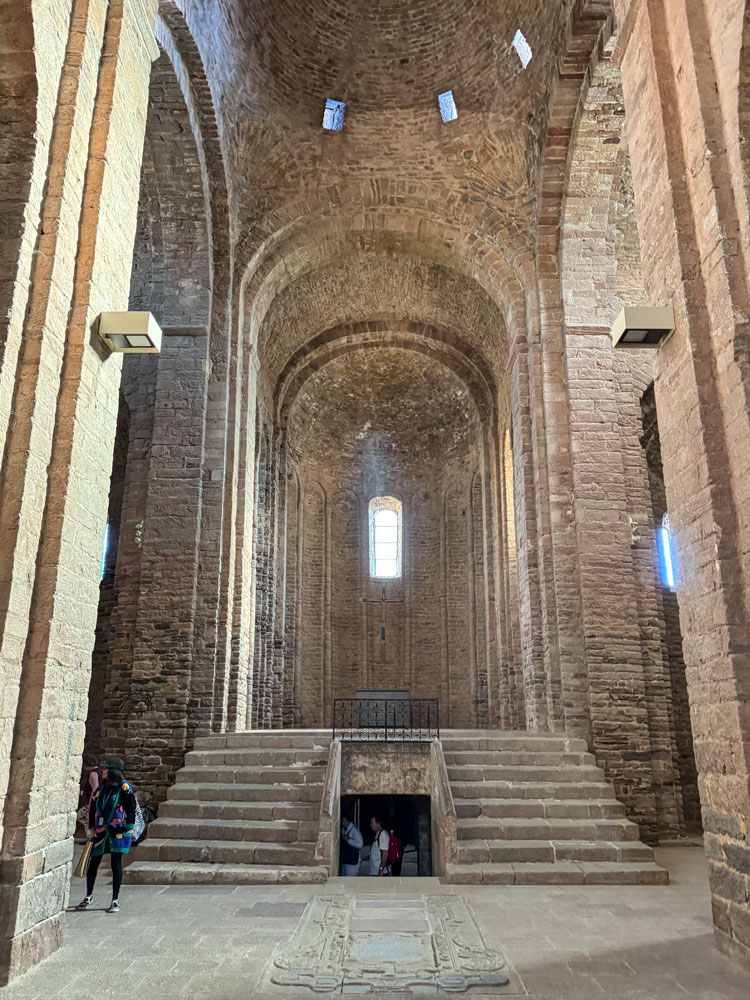
We left the church and took a bus to the town, where we went to the main square.
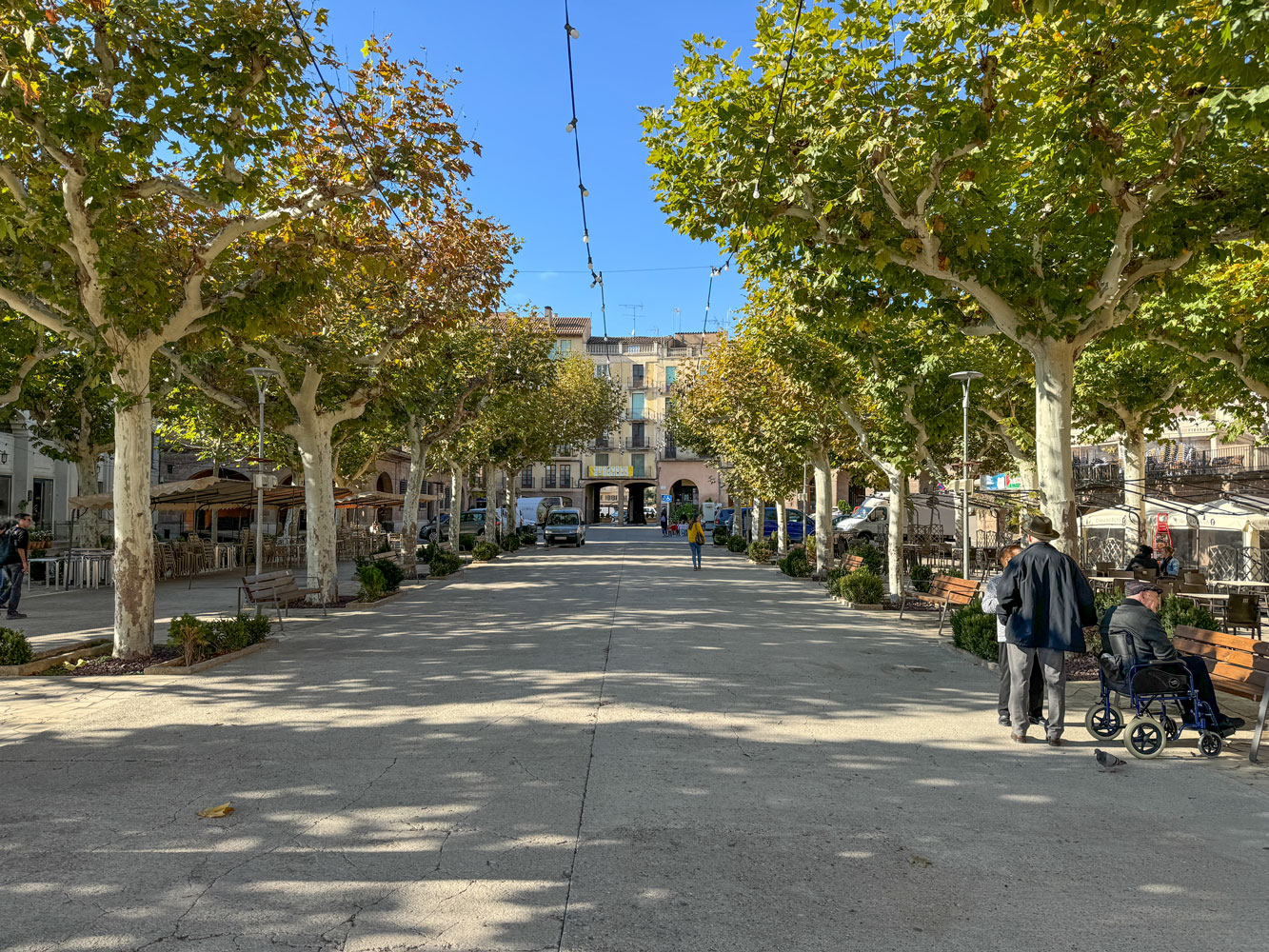
There was a good view of the castle from the square.
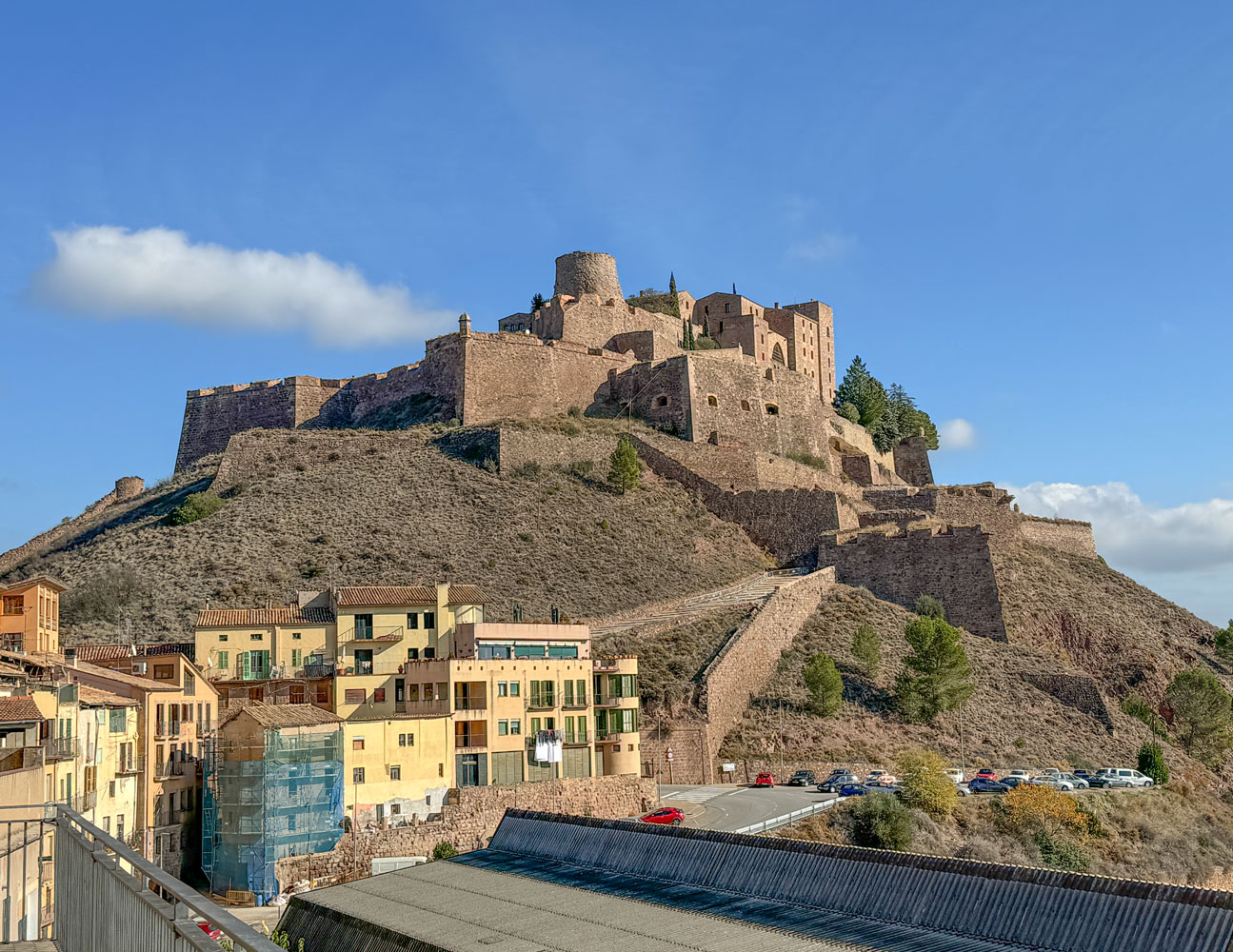
Judy took this picture of me with the castle in the background.
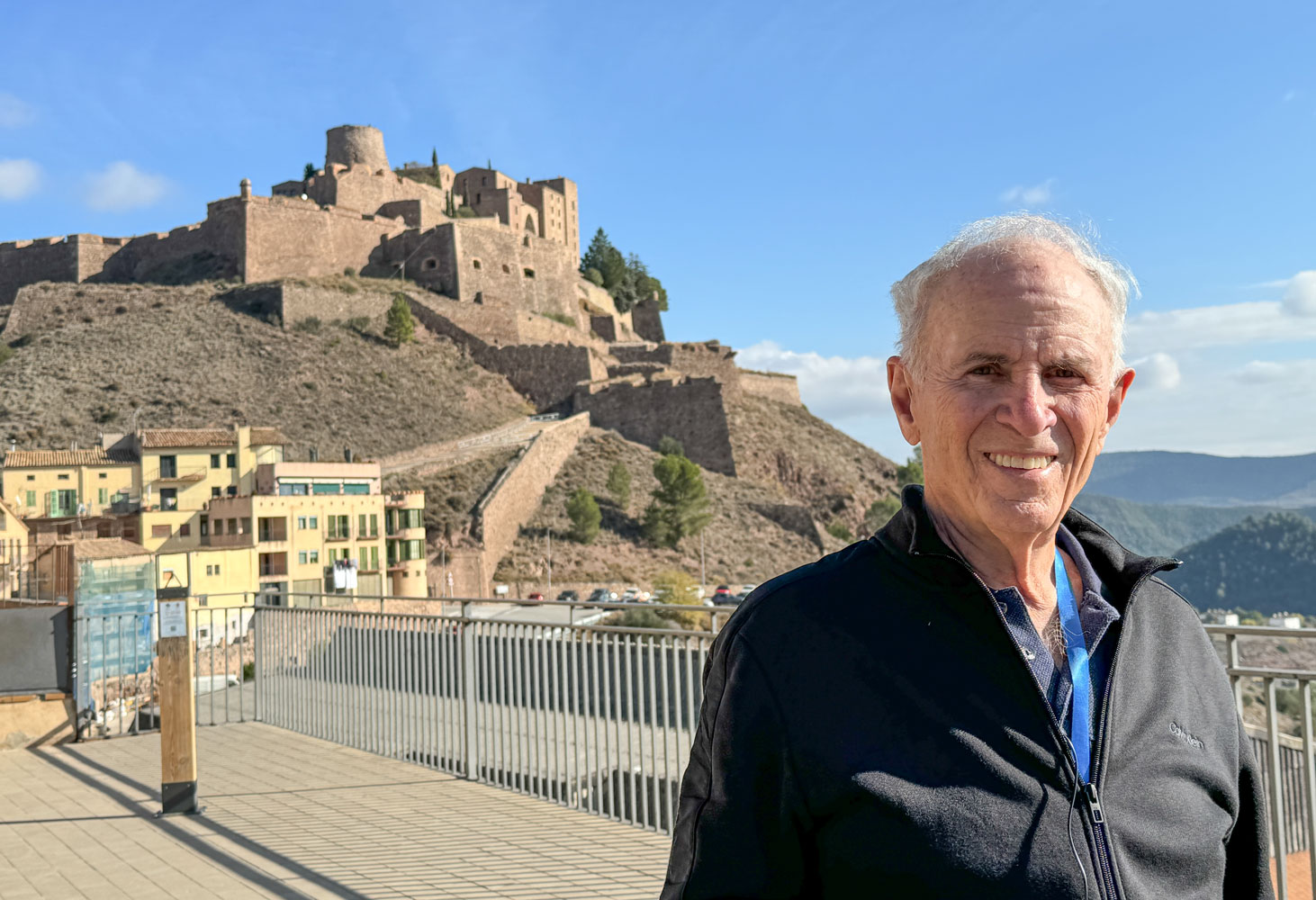
And then Maria took a group picture.

After the group picture, we walked into the town to visit the Church of Saint Miguel (website is in Spanish but Google will translate it for you). The church was originally built in the 11th Century.
There are some similarities between this church and the Church of Sant Vicenç. Note the similar arrangement of the altar area and the crypt under the altar. However, the windows are larger in this church, and the walls not as massive.
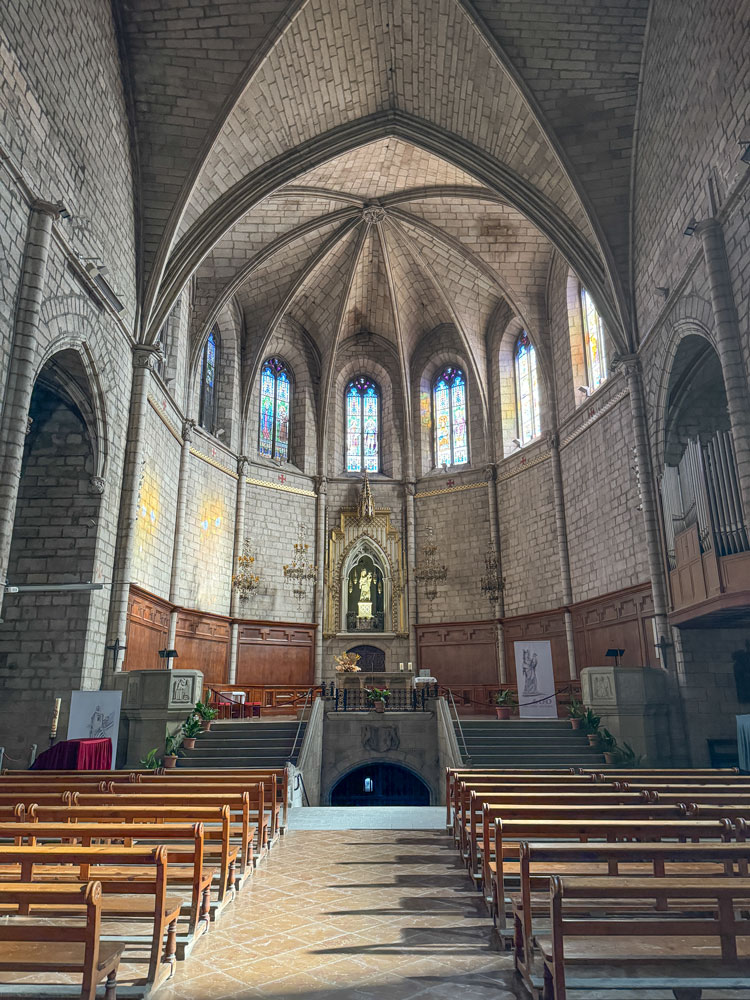
In the church is this eagle. Certain parades in the Barcelona area include figures like this eagle, or a famous man or woman. A "carrier", usually a man because of the weight of the figure, puts his head and upper body into the figure from below and carries it in the parade. The parade stops at regular intervals and the carrier may swap with another person to carry the figure. The eagle represents Spain.
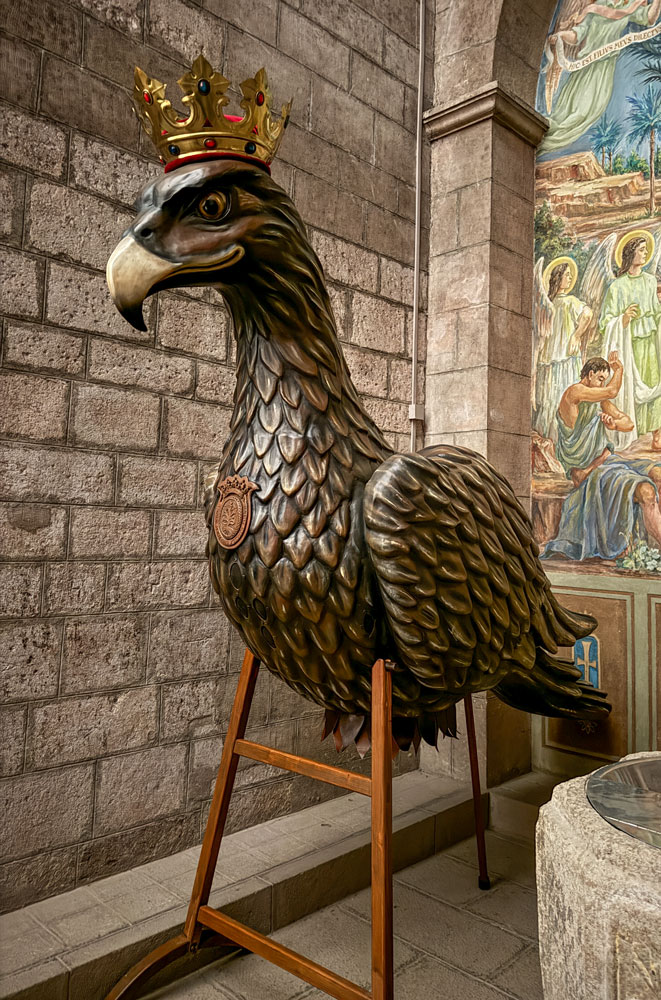
After the visit to the church we took a bus to the Cardona salt mountain and mine. Salt has been extracted from this area since Neolithic times, but it was done by open pit techniques. The Romans controlled this area during the time of the Roman Empire and they probably began the tunnel mining of the salt. By Medieval times, Cardona was the most important salt producer on the Iberian Peninsula and its salt was exported to the rest of Europe through the port of Barcelona. Cardona became somewhat wealthy from this export.
Significant deposits of potash were discovered in the salt area in early 1900s which led to a significant increase in the mining and growth of Cardona. In 1923, the Spanish Union of Explosives bought the mine and operated it until 1990, when the mine was no longer economically viable. The mine is now a tourist attraction.
Salt was very important in early times and was quite valuable. Workers were often paid in salt, which is where our word "salary" comes from. We also have saying, such as "Worth his salt", "Take some fact with a grain of salt", "Above (or below) the salt", "Rub salt into the wound", "Salt of the earth", "Put salt on a bird's tail", and several others.
We were told that workers at the salt mine were paid (at least partially) in salt, but I question that. Any worker in the salt mine could easily put some salt into his pocket or a small bag and take it home daily. It might not be the best salt - it might be salt from the tailings - but it would be valuable to the worker's family as the only way to preserve food.
We arrived at the parking lot of the mine area. There's a gift shop (of course) and a statue to represent the miners. I imagine the miner is idealized. Pictures we saw later showed miners working in nothing but shoes and shorts.
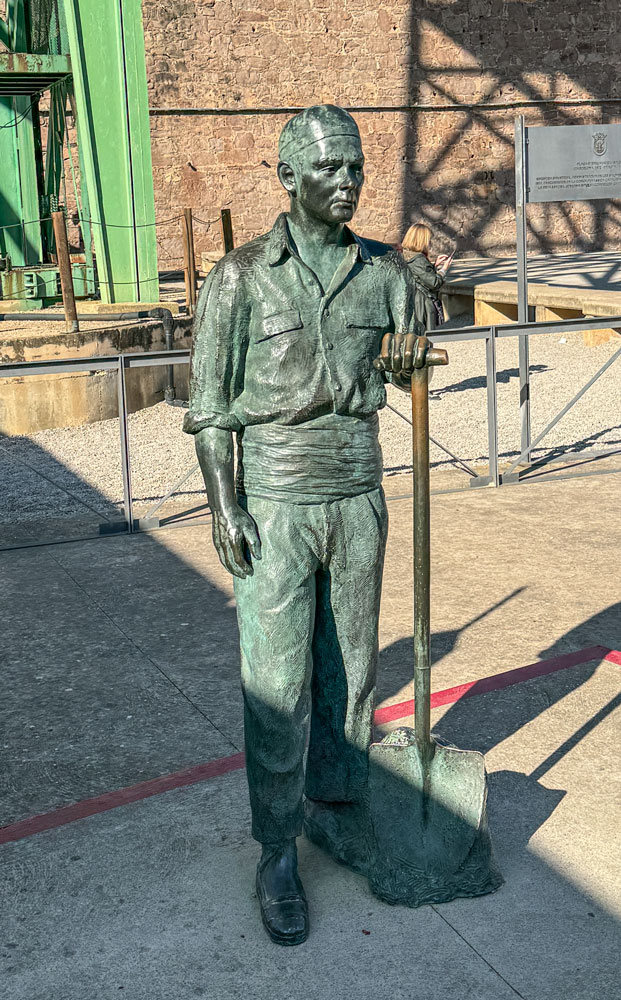
Conditions for the miners during the Roman period must have been particularly brutal. Rome was almost constantly at war and war captives were used as slaves or sold into slavery to other countries. That's how Julius Caesar became rich, by selling captives from the Gallic Wars. As a side note, the book, "War Commentaries of Caesar" is a good read about those wars, if you're interested in military history (see also here). It's one-sided, of course - Caesar wanted to make himself look good.
From the parking lot you can see the castle. Think about living here in Medieval times. Perhaps you were a peasant farmer who worked the land around the castle. Of course, that land belonged to the owner of the castle and he came down occasionally to collect the tax.
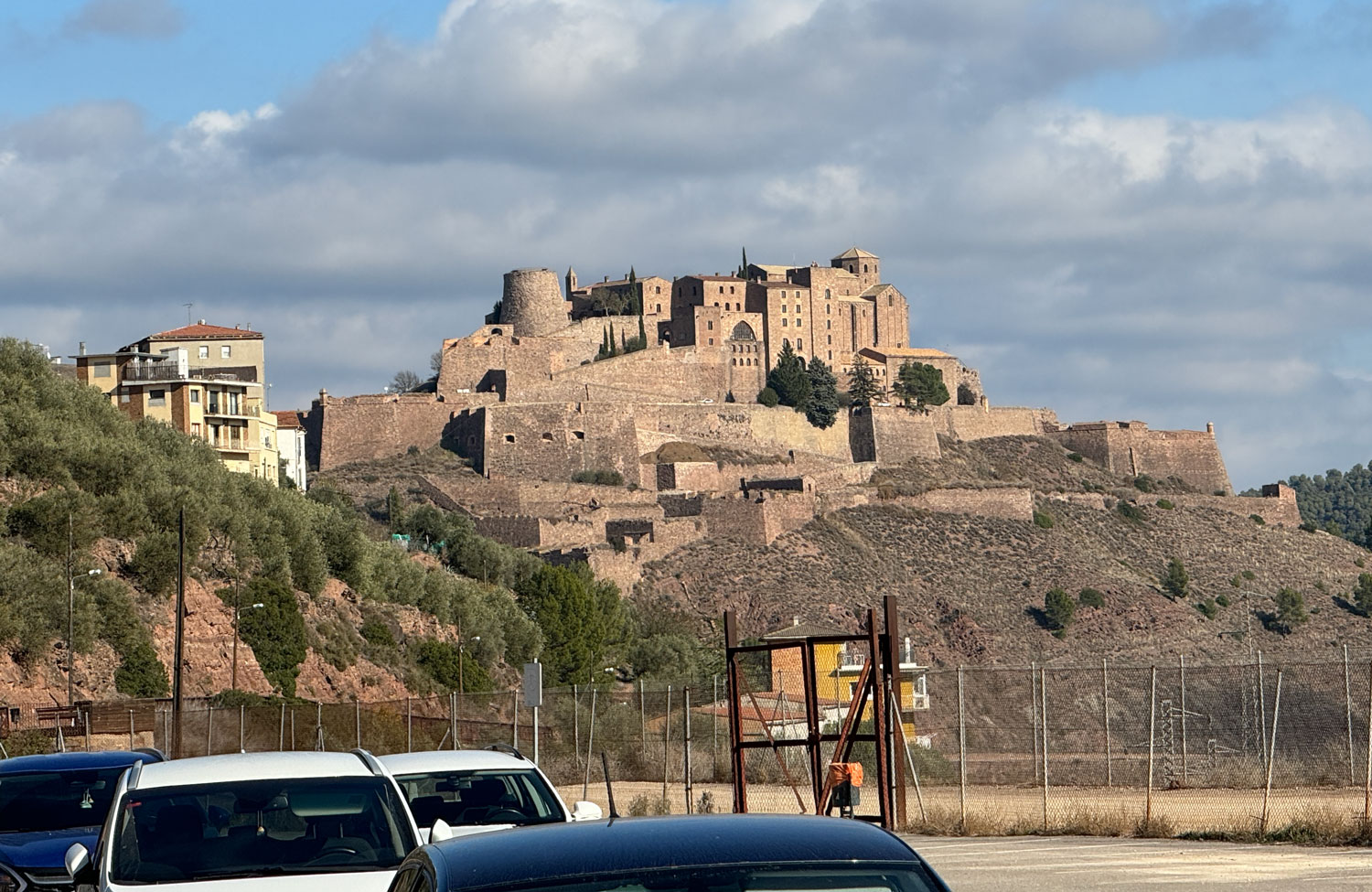
From the parking lot, we rode in a salt mine bus down to the area of the mine.
Here's the view as we approached the mountain and the entrance to the mine.
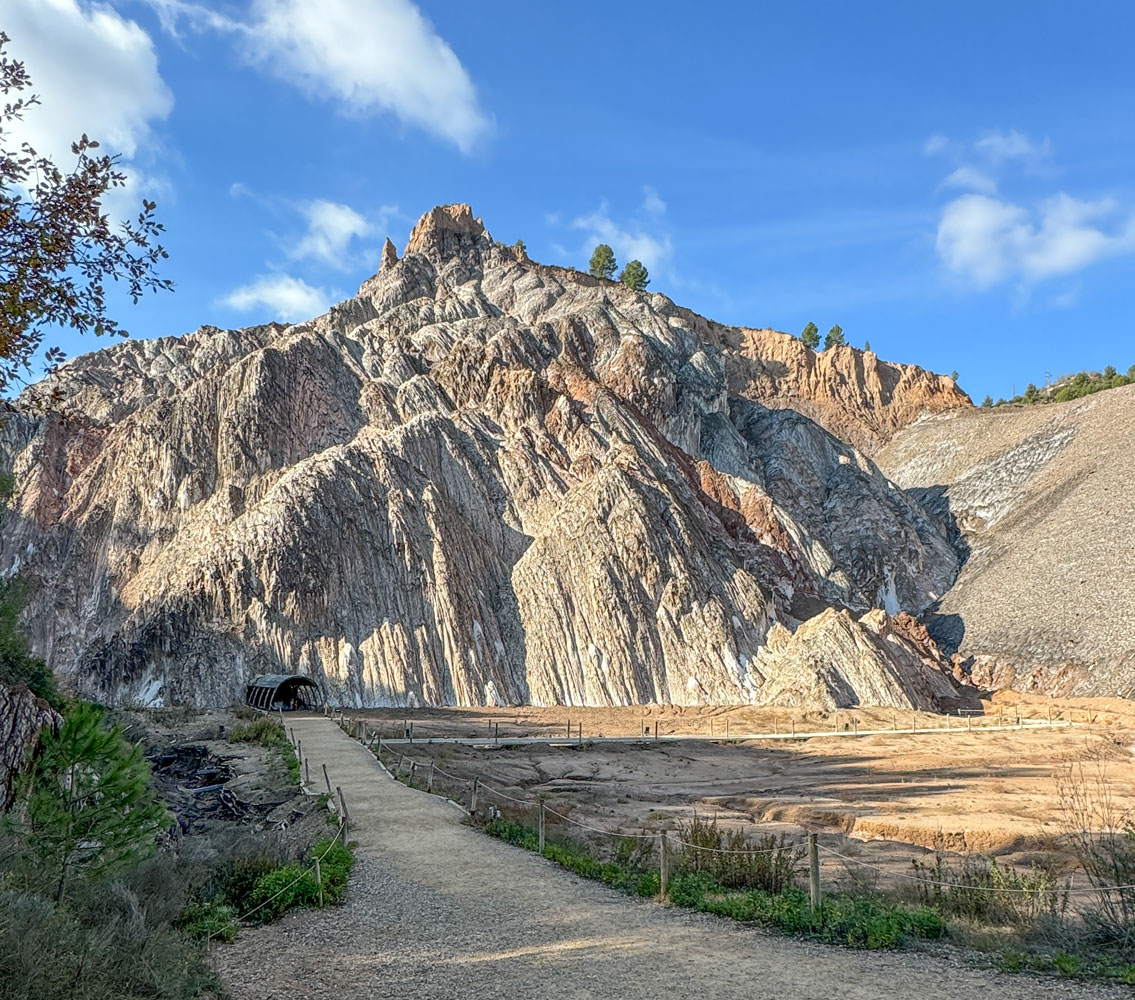
And a closer view of the entrance to the mine.

We all had to wear a hard hat in the mine. Not because anything might fall on us, but in places the tunnel was fairly low and people would bump their head - and people did.

A view into the tunnel as we entered.
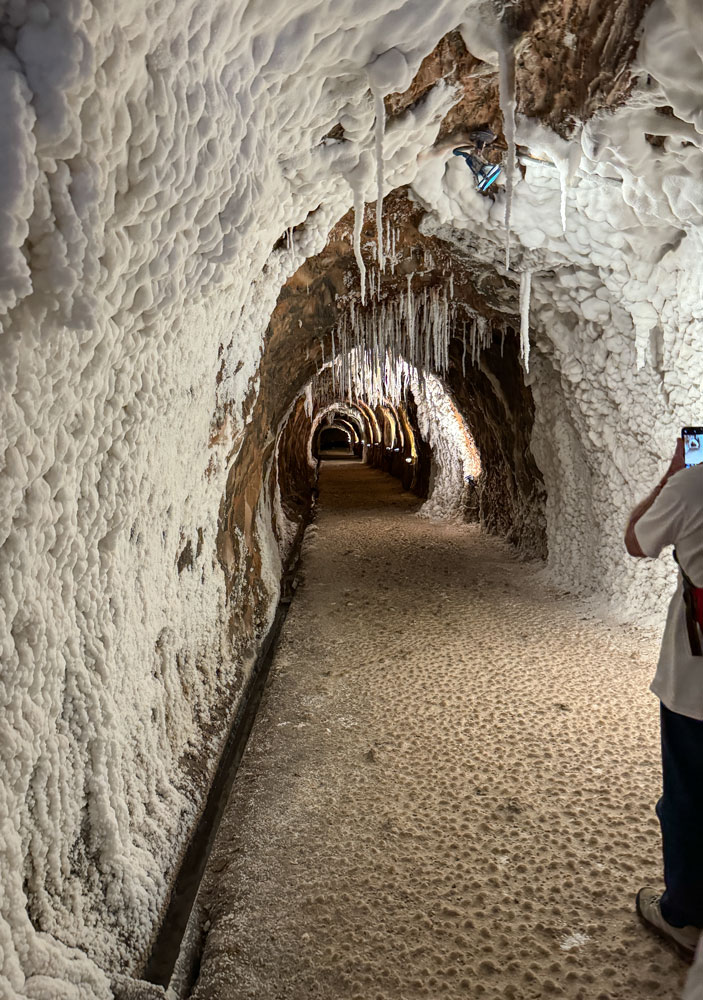
In places, the walls of the tunnel were quite interesting. Before being uplifted millions of years ago, the salt was laid down in layers as the sea alternately evaporated and then refilled, with sand or clay between layers. The land was warped during tetonic uplifts, giving us these interesting designs.
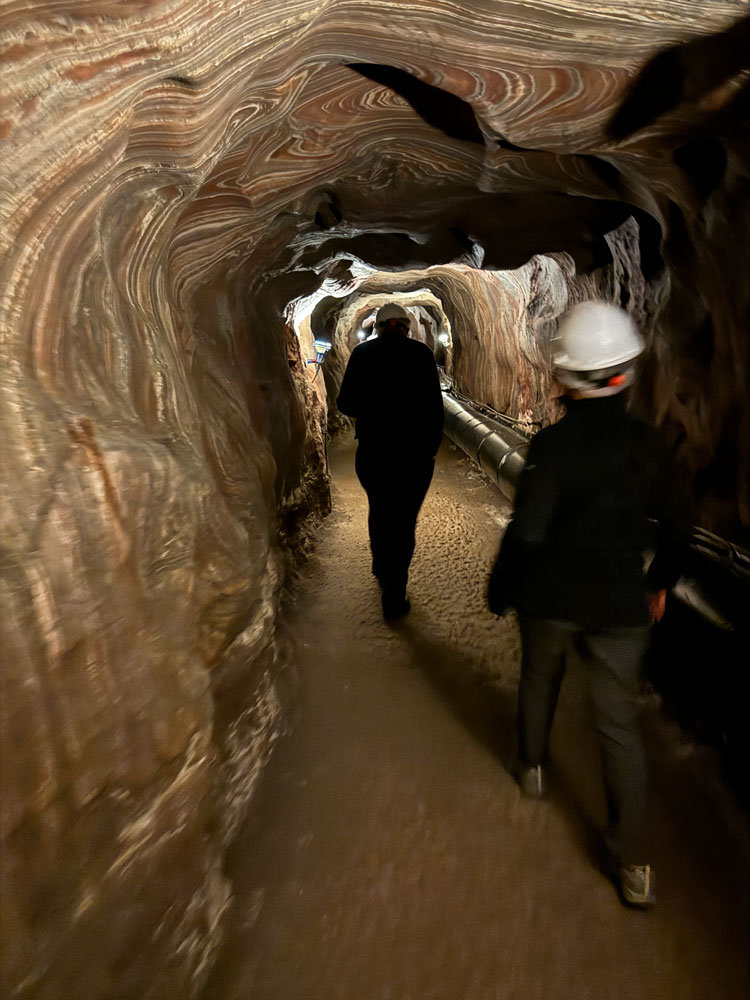
A closer view of an area of the wall.
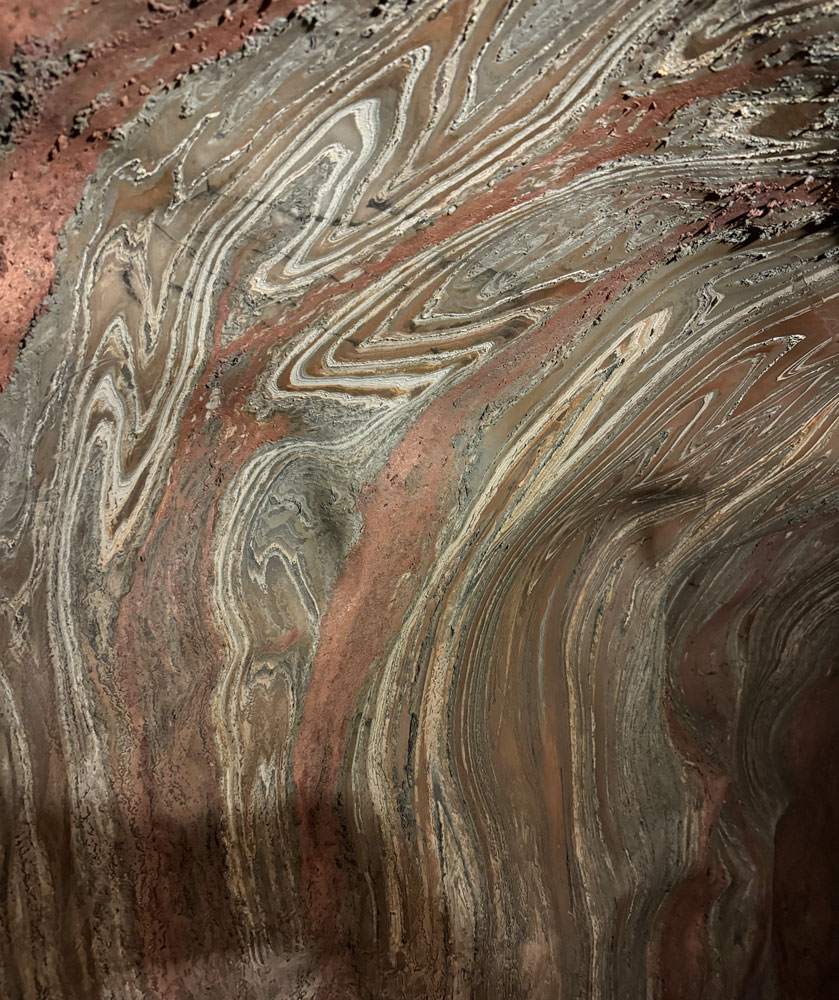
We came to an area where water percolates through the mountain, dissolving salt. As the water drips down, it evaporates, forming salt stalactites (hanging from the ceiling) and stalagmites (built up on the floor).
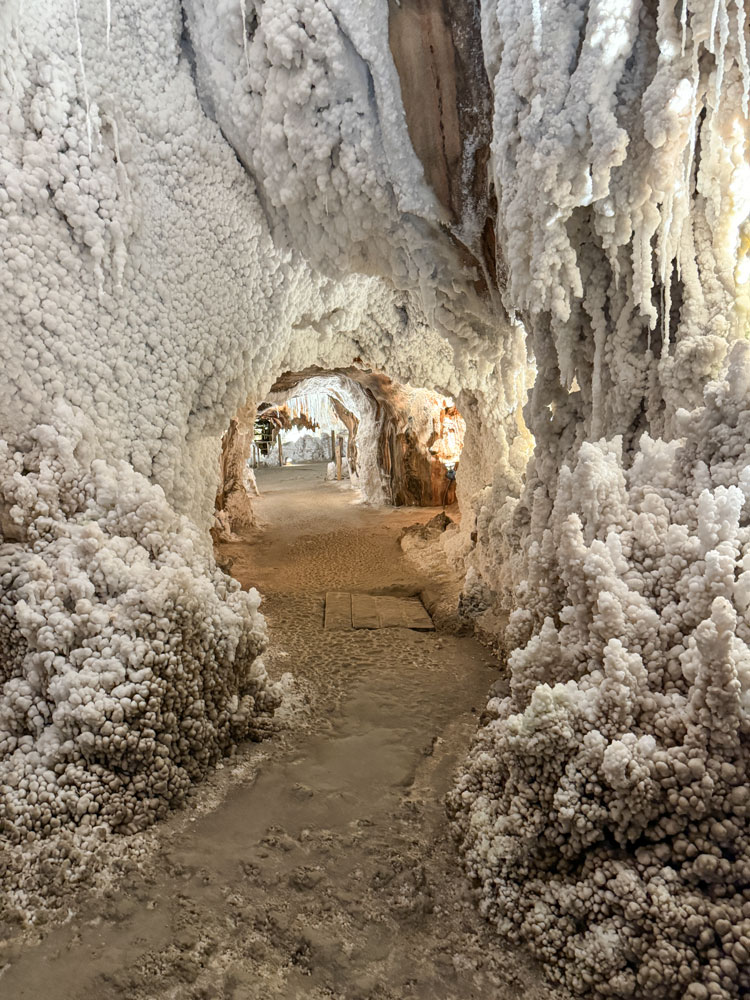
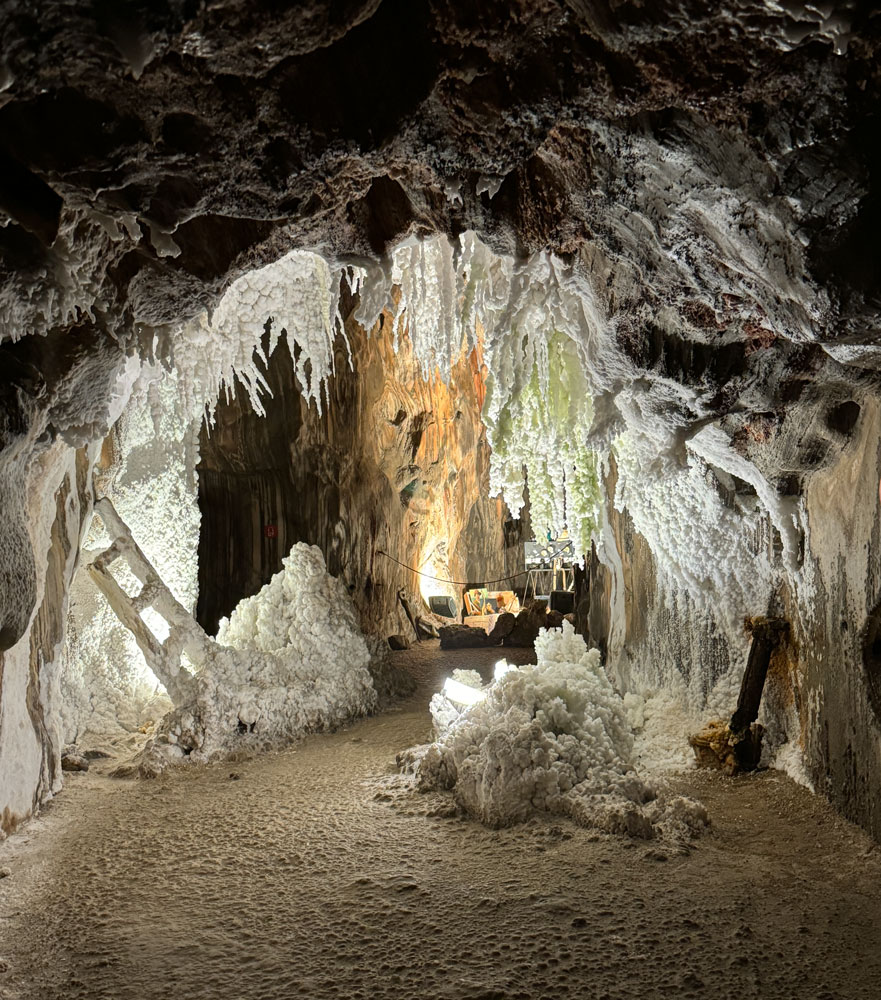
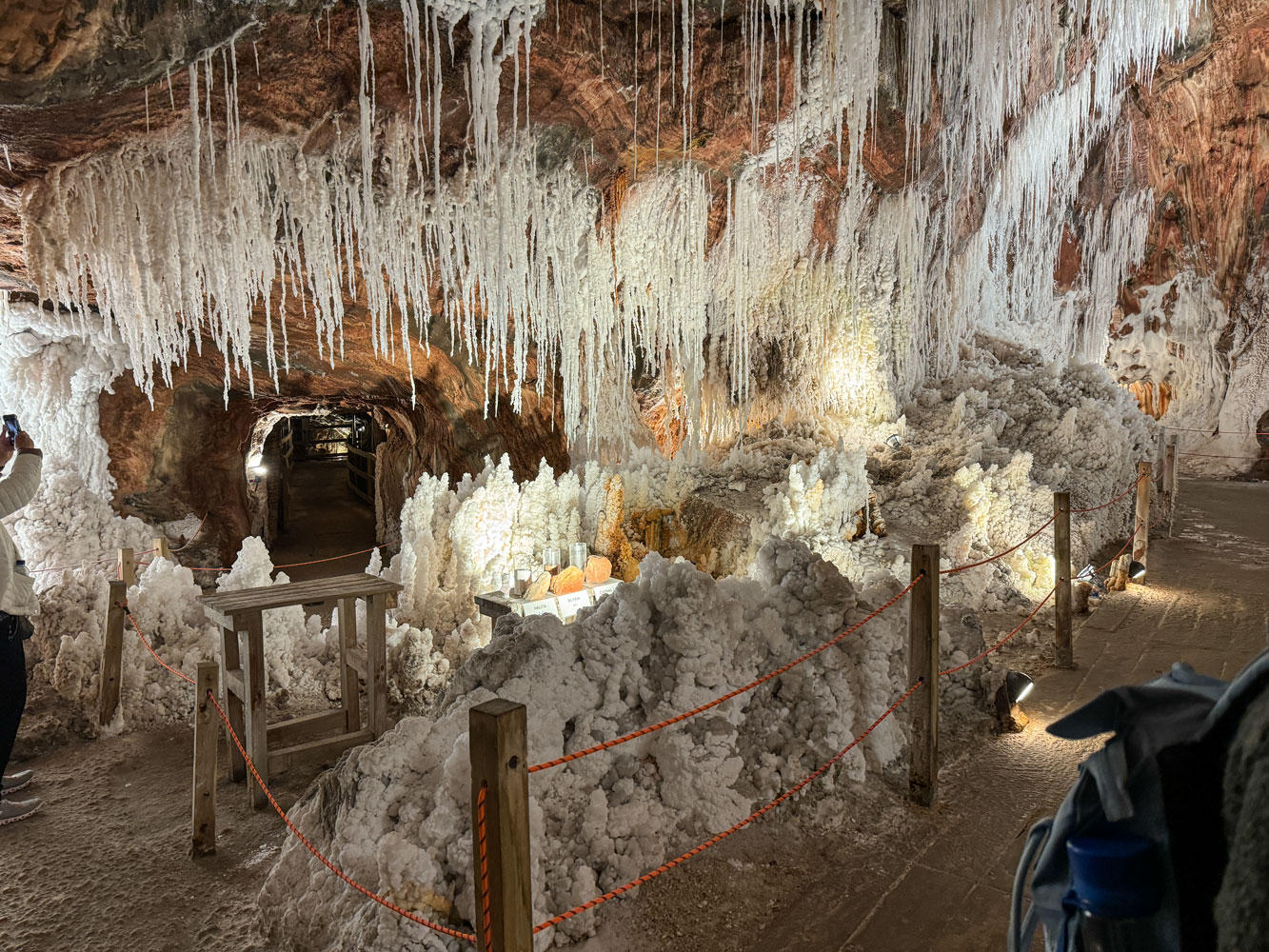
After touring the mine we boarded the bus, which took us back to the town and the hotel. Some of our group got out at the town, but Judy and I went back to the hotel and took a nap.
We had our final dinner at the hotel, and then to bed.

Tomorrow we travel from Cardona to the cruise ship port in Barcelona and board the Regent Voyager ship.